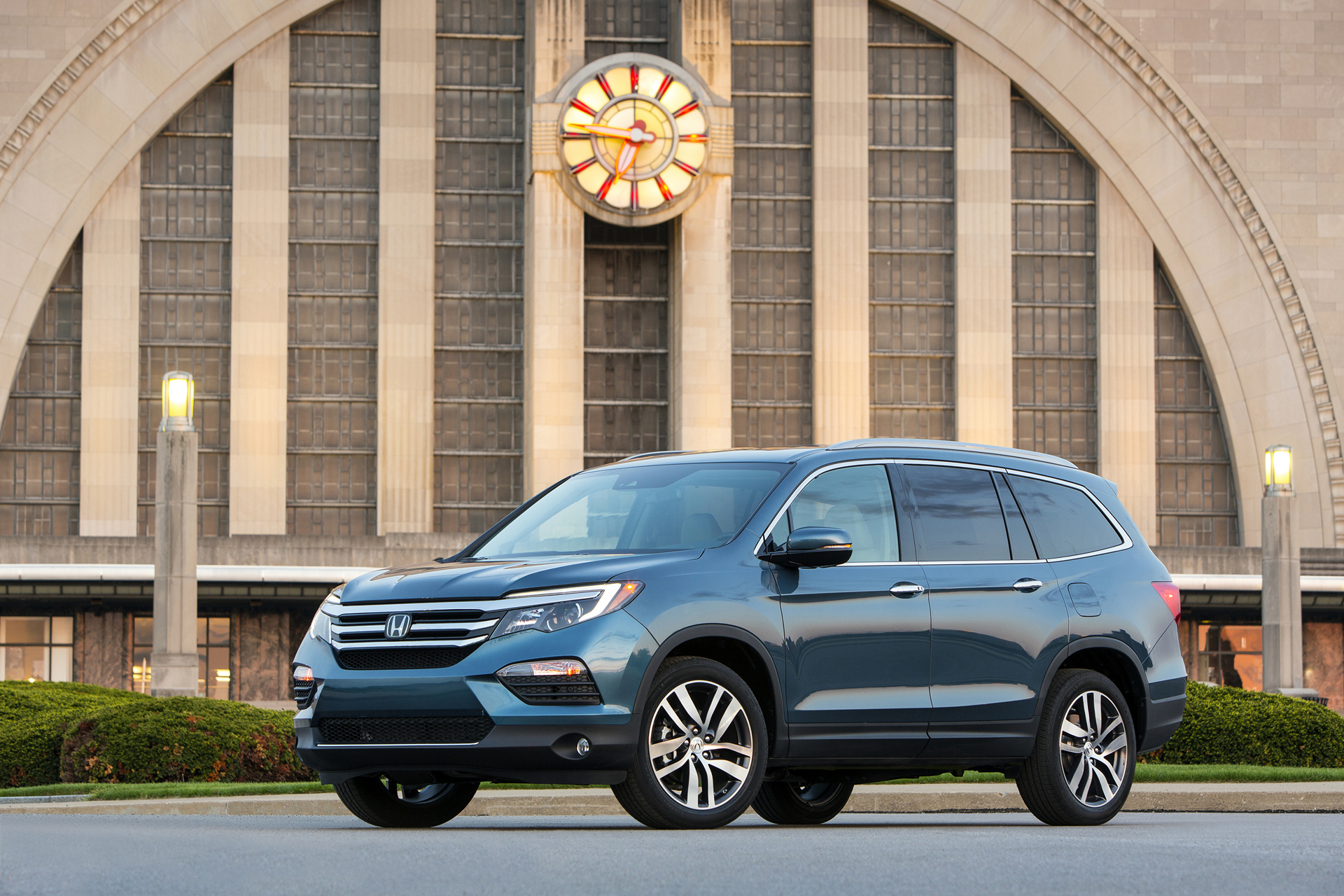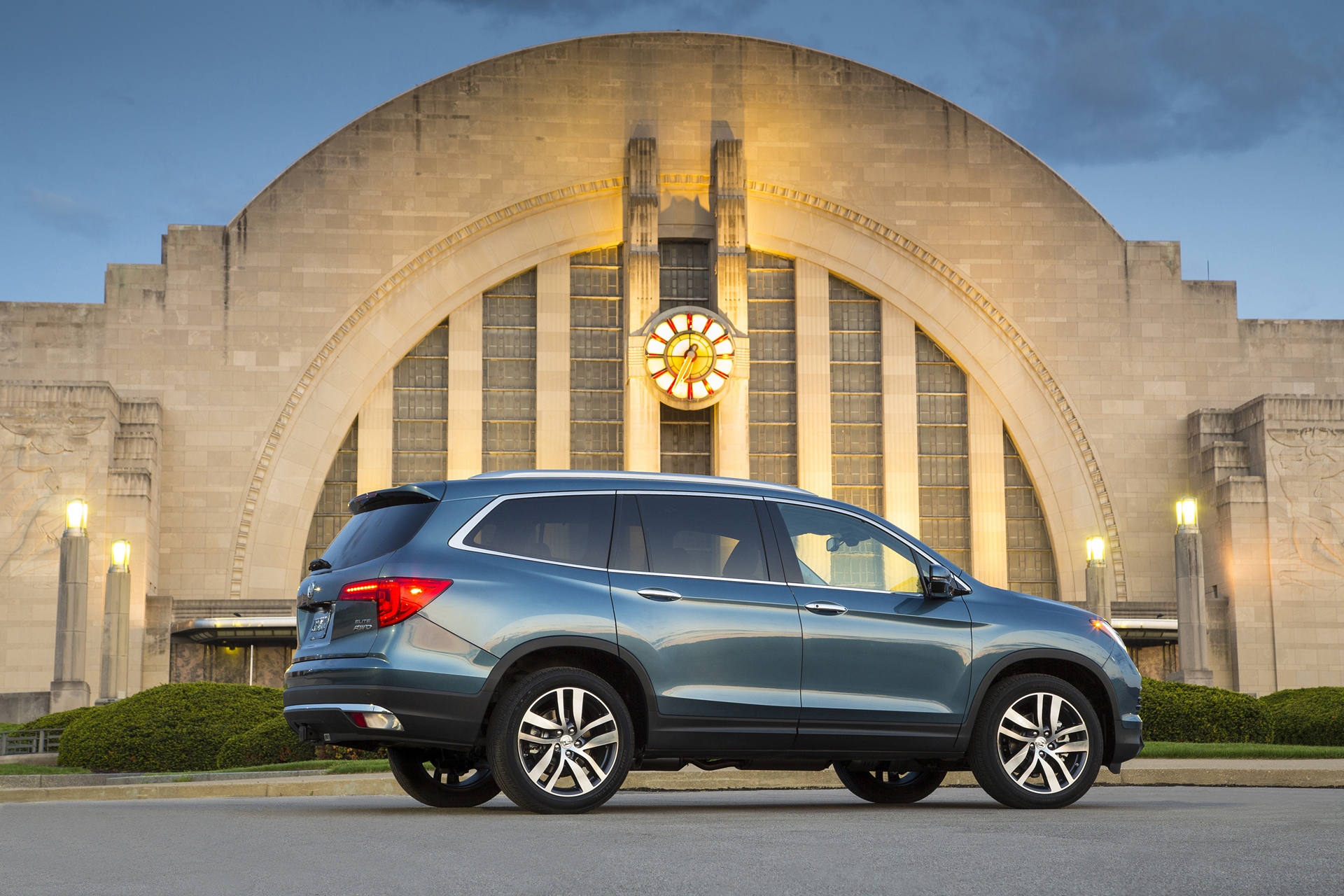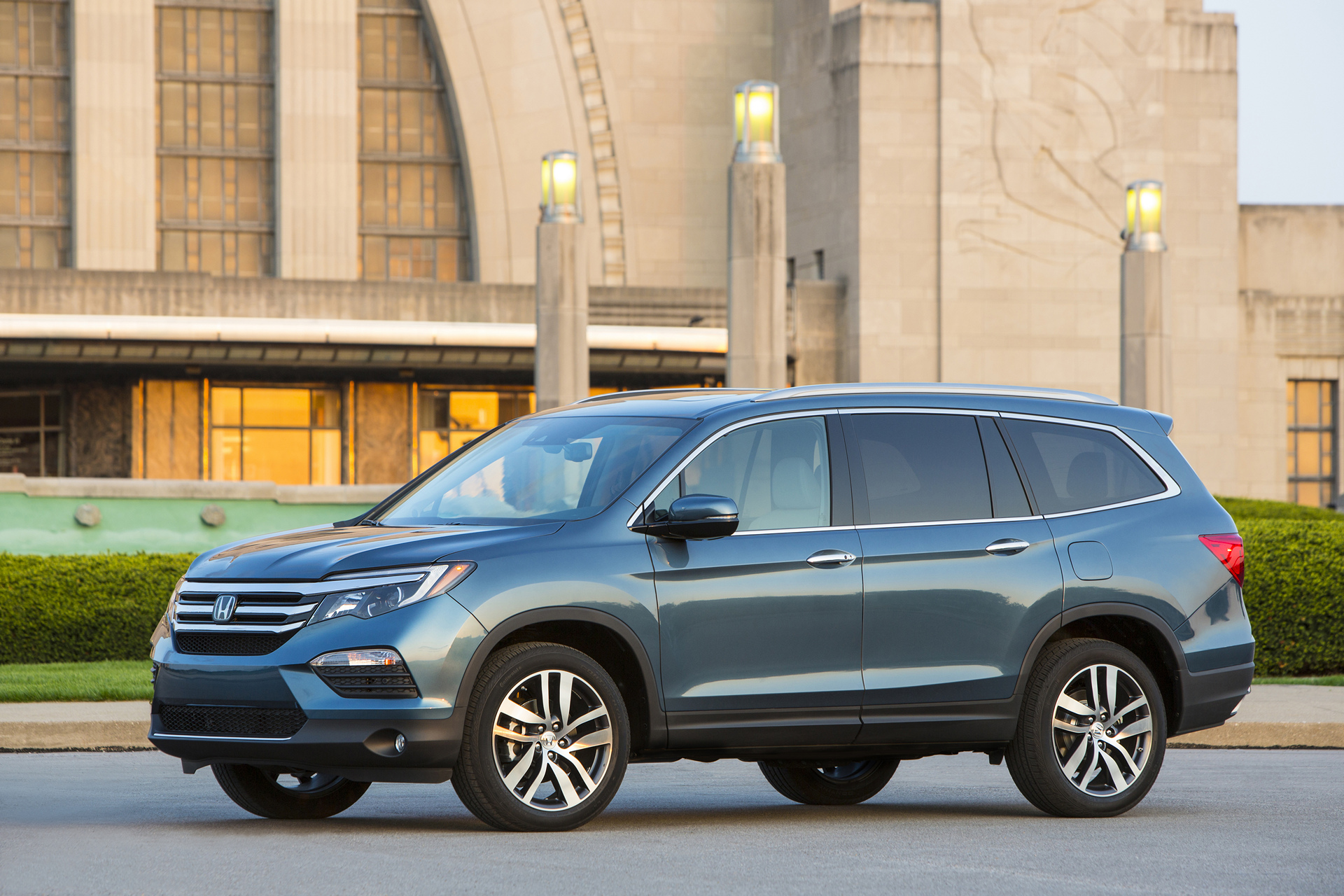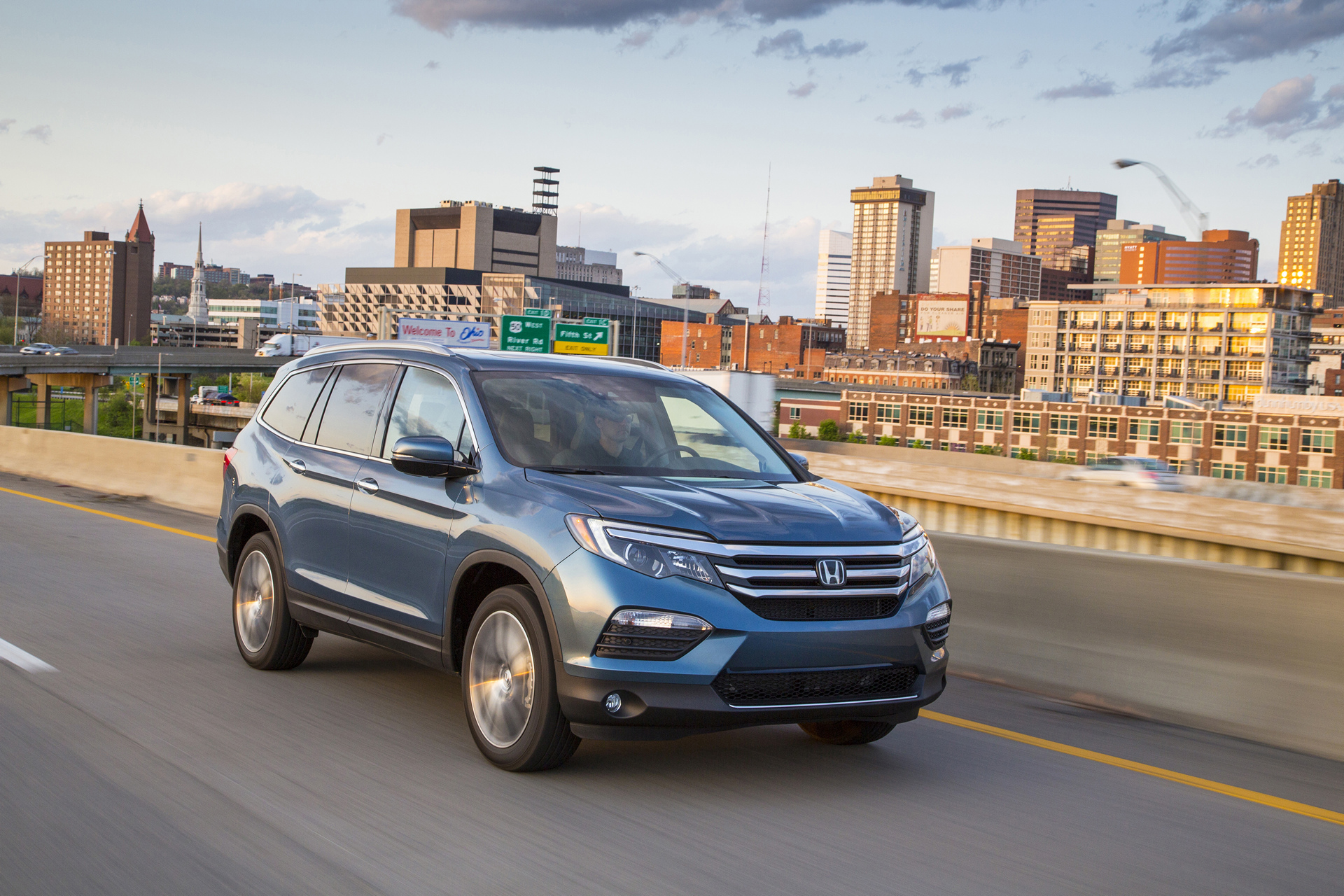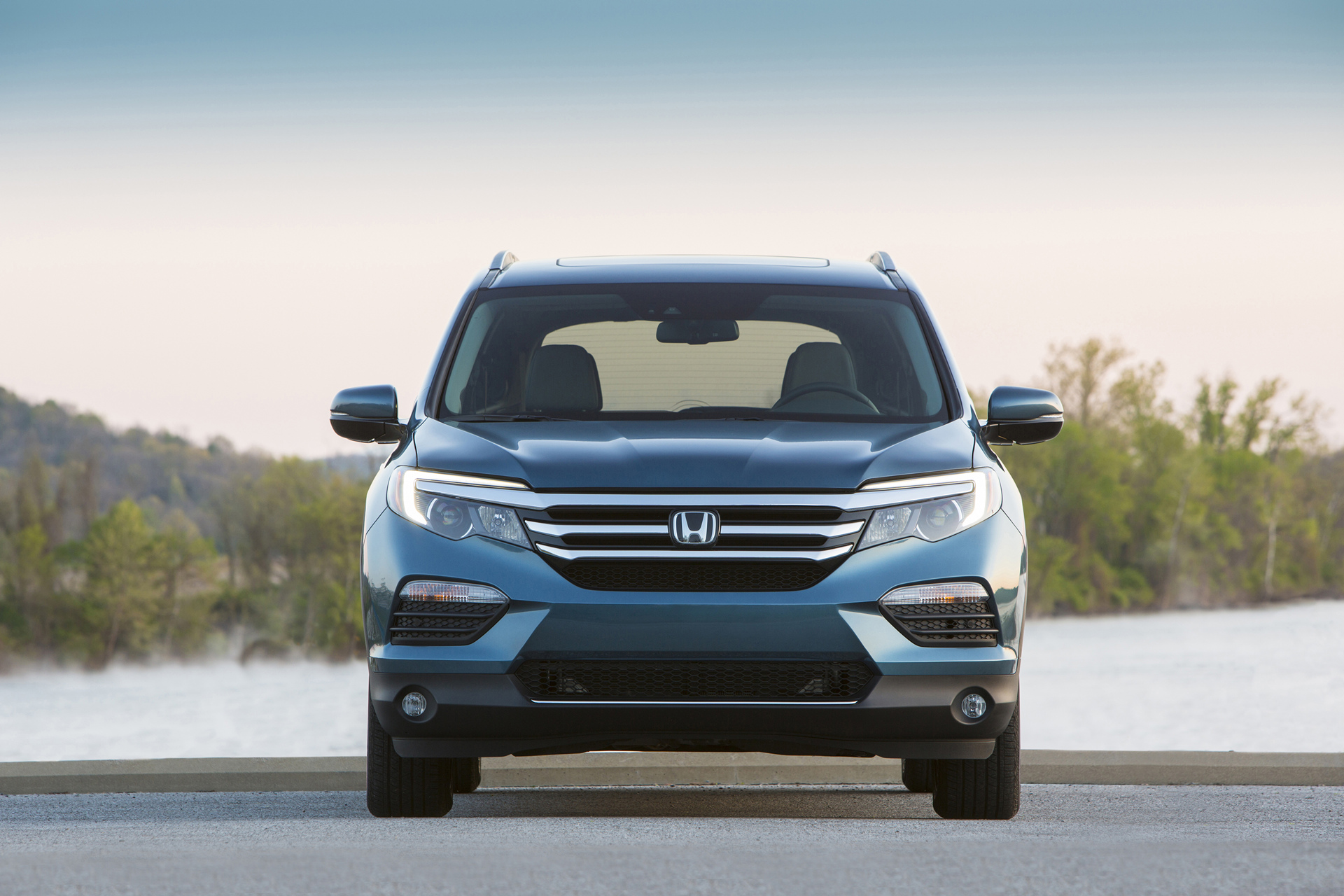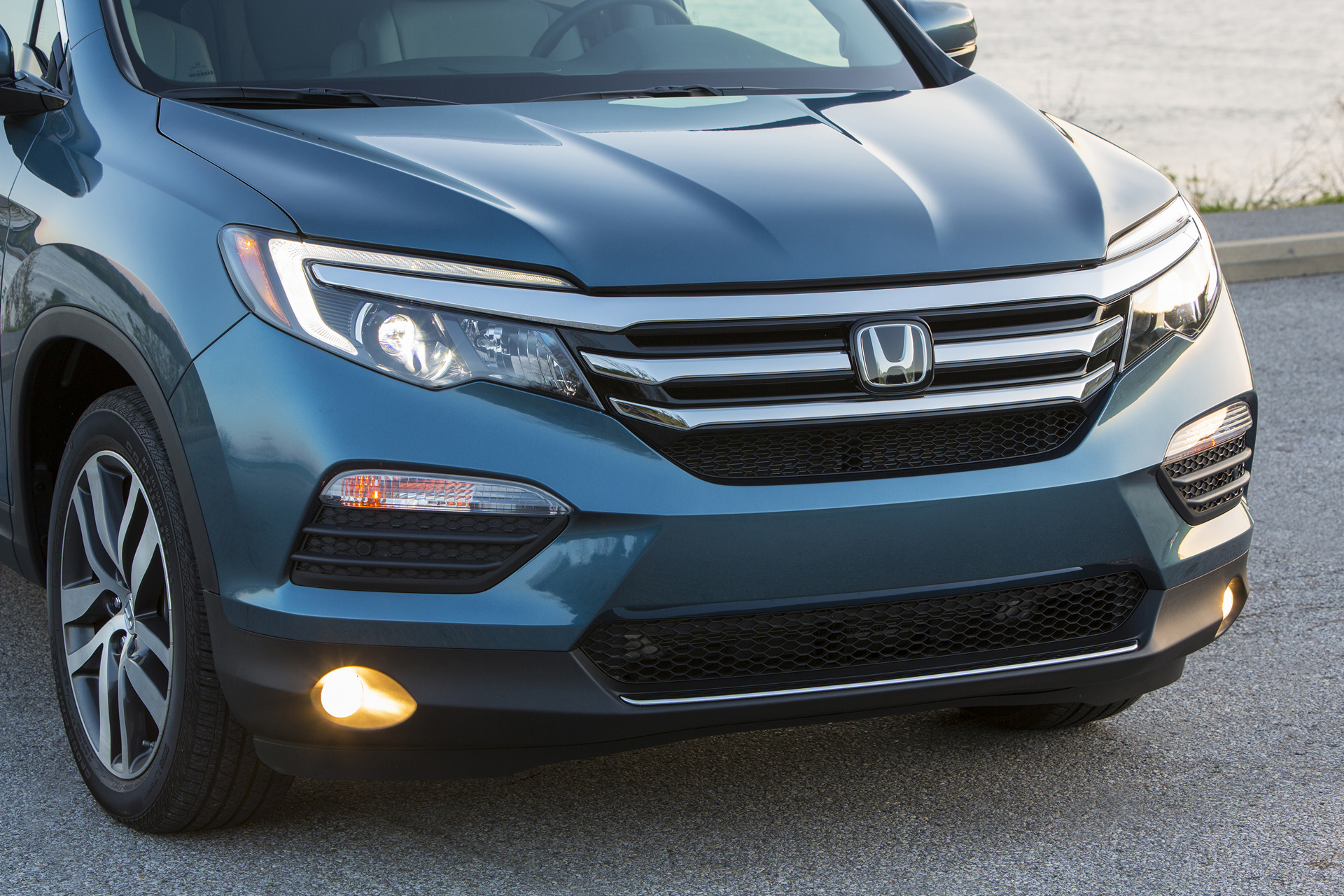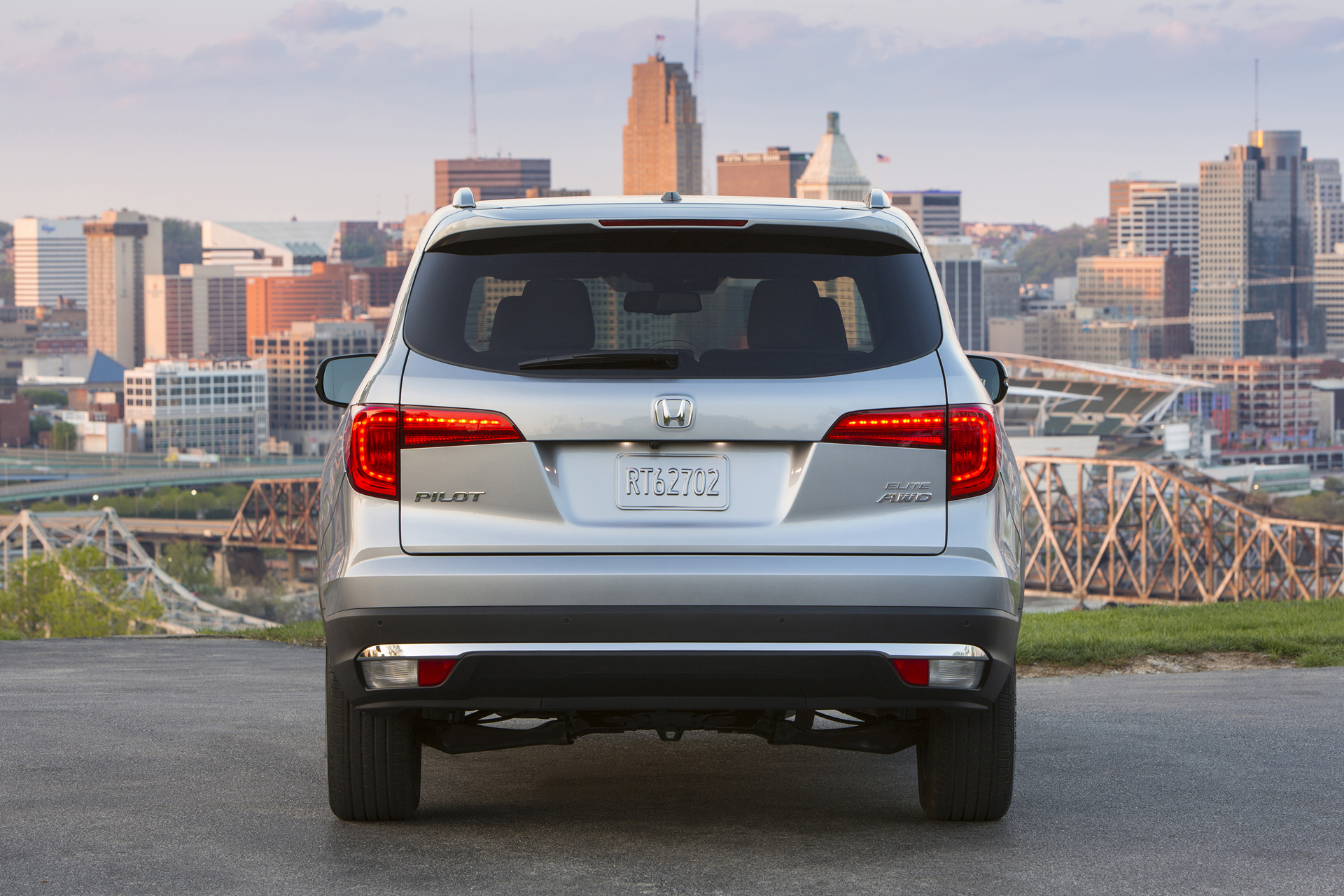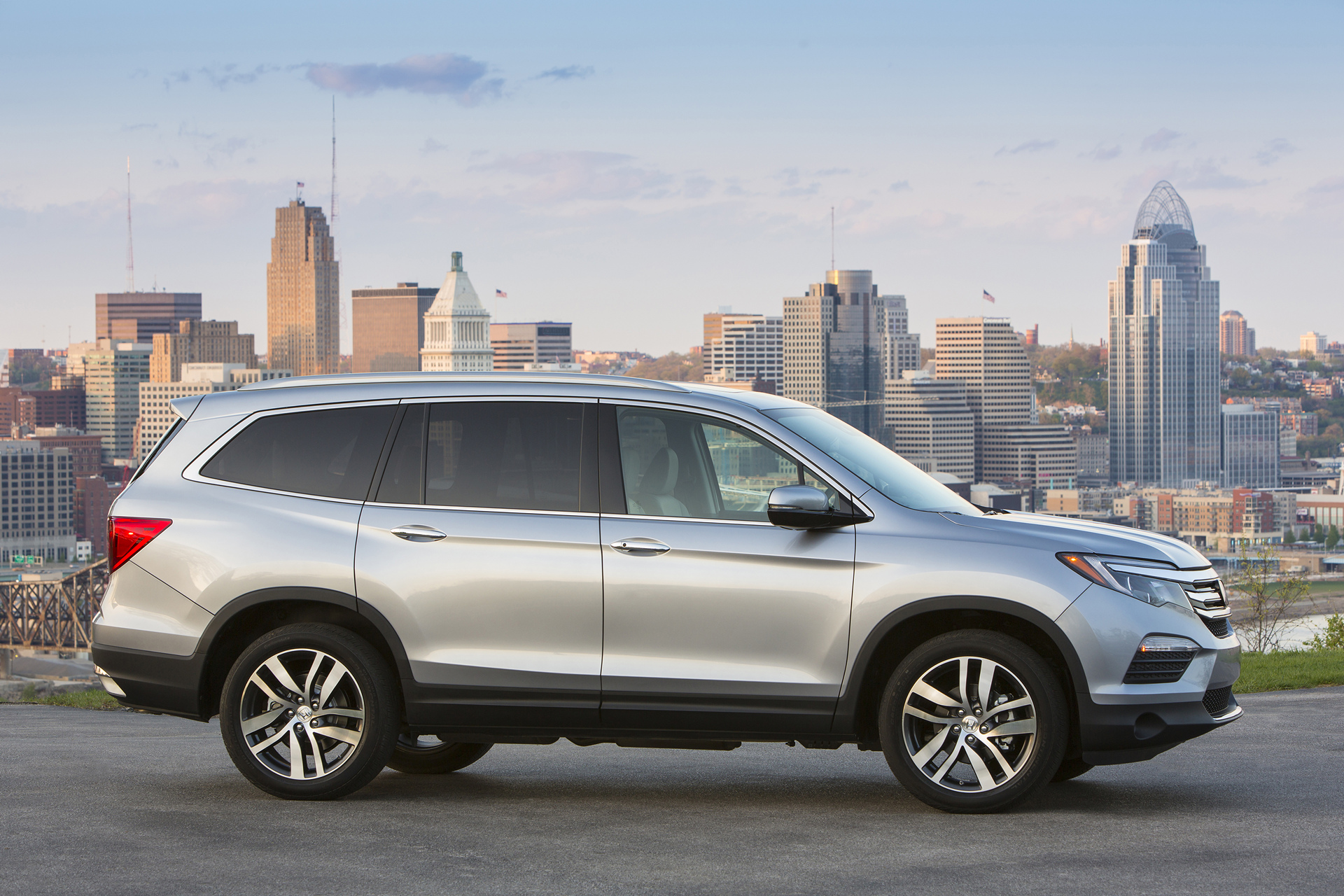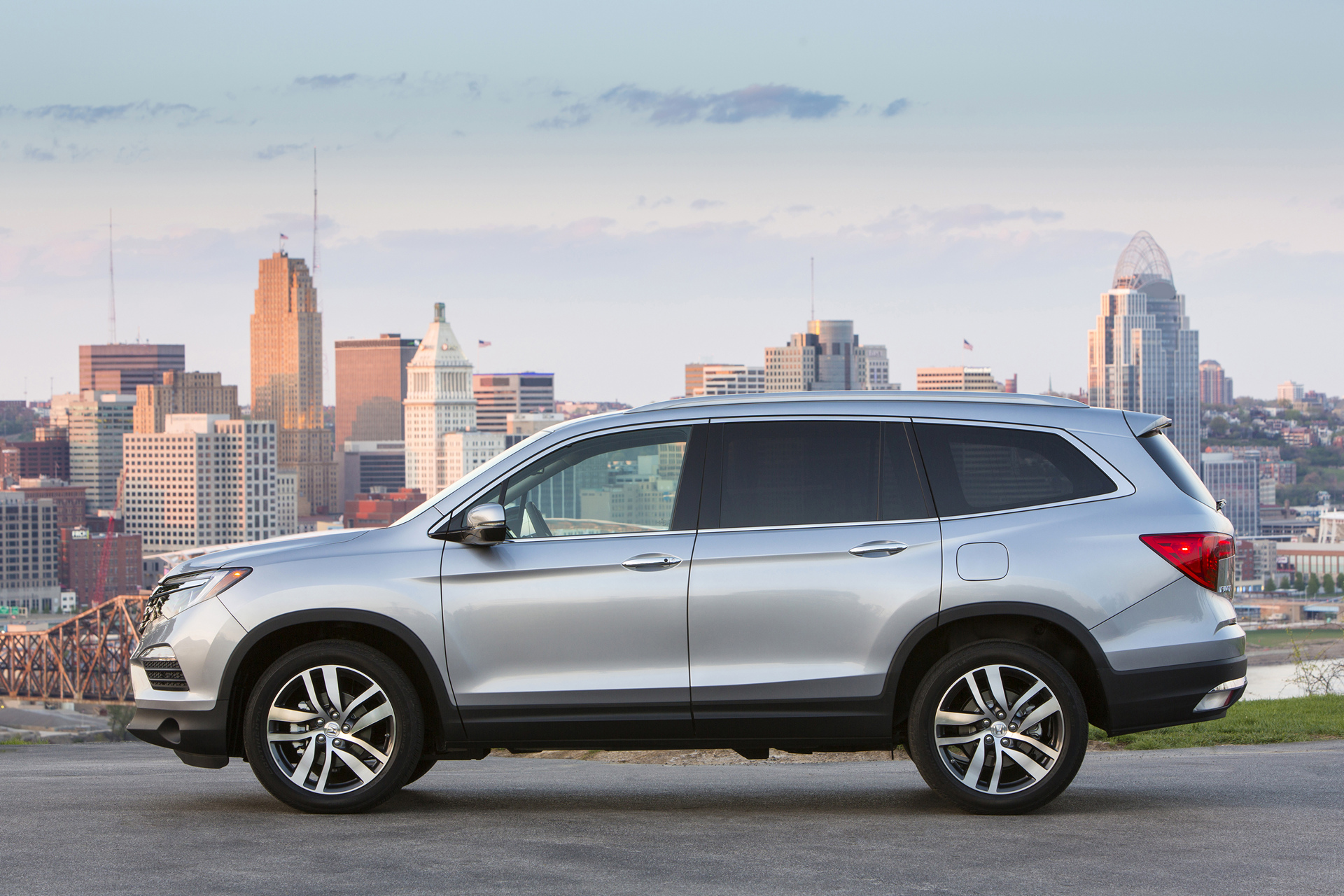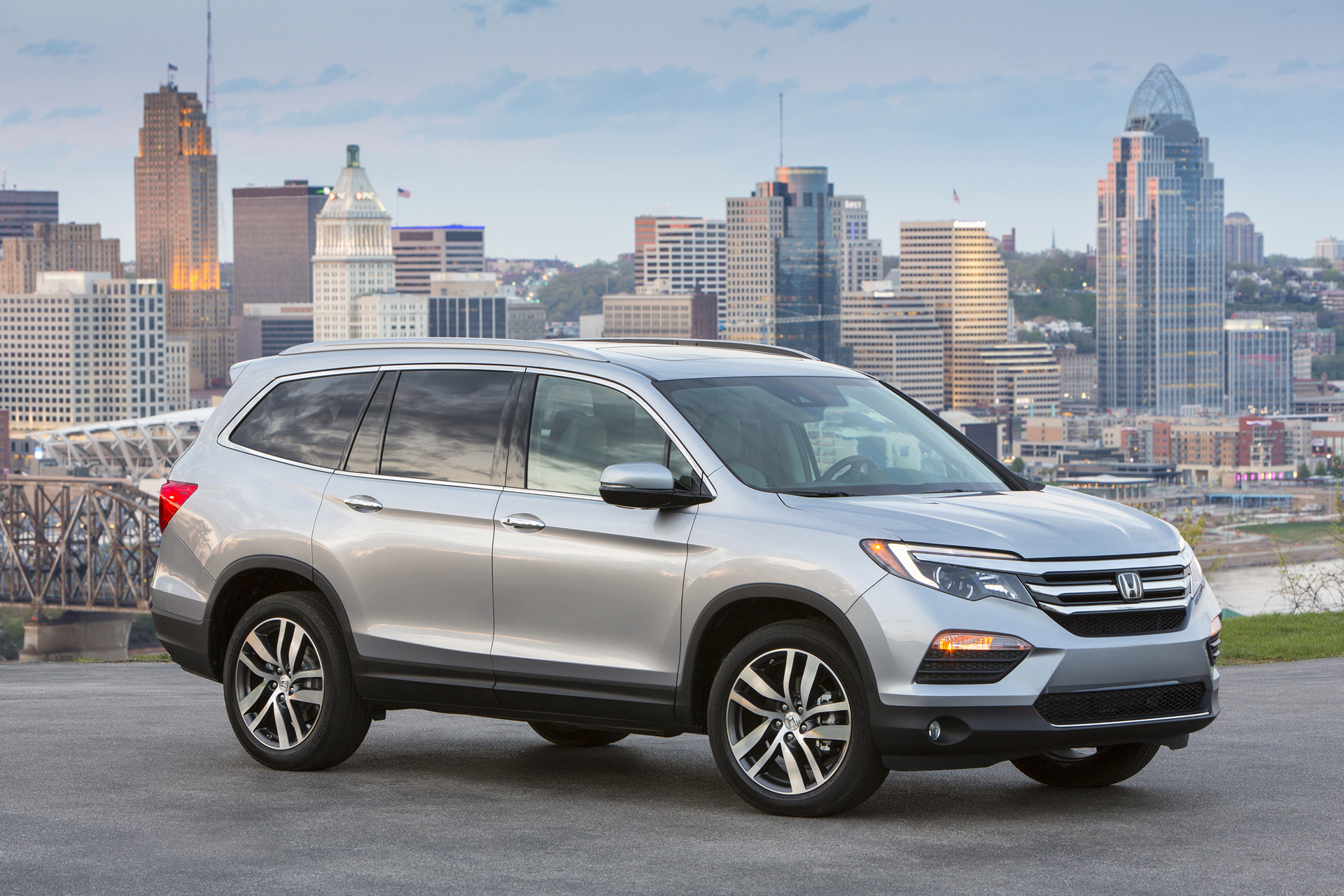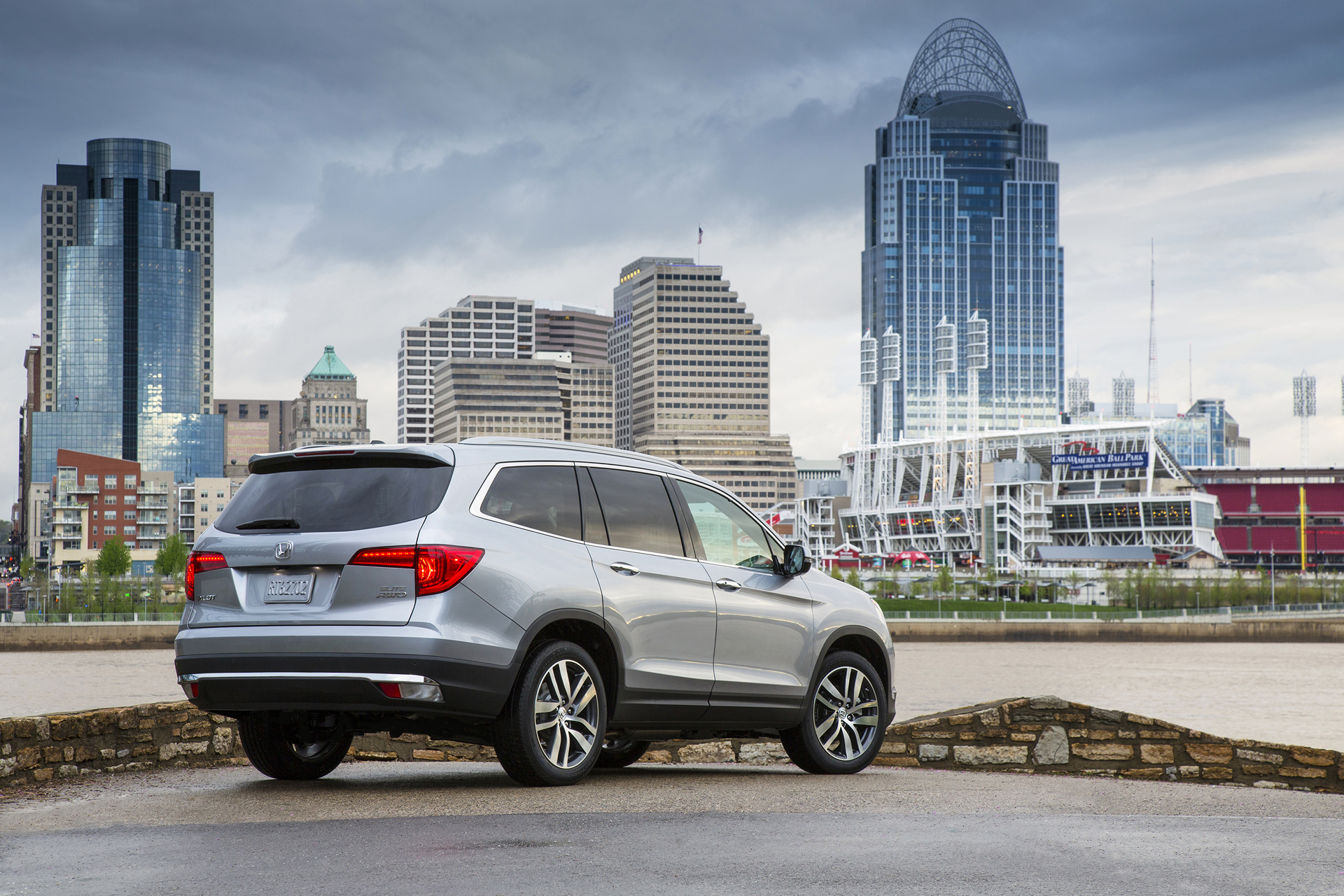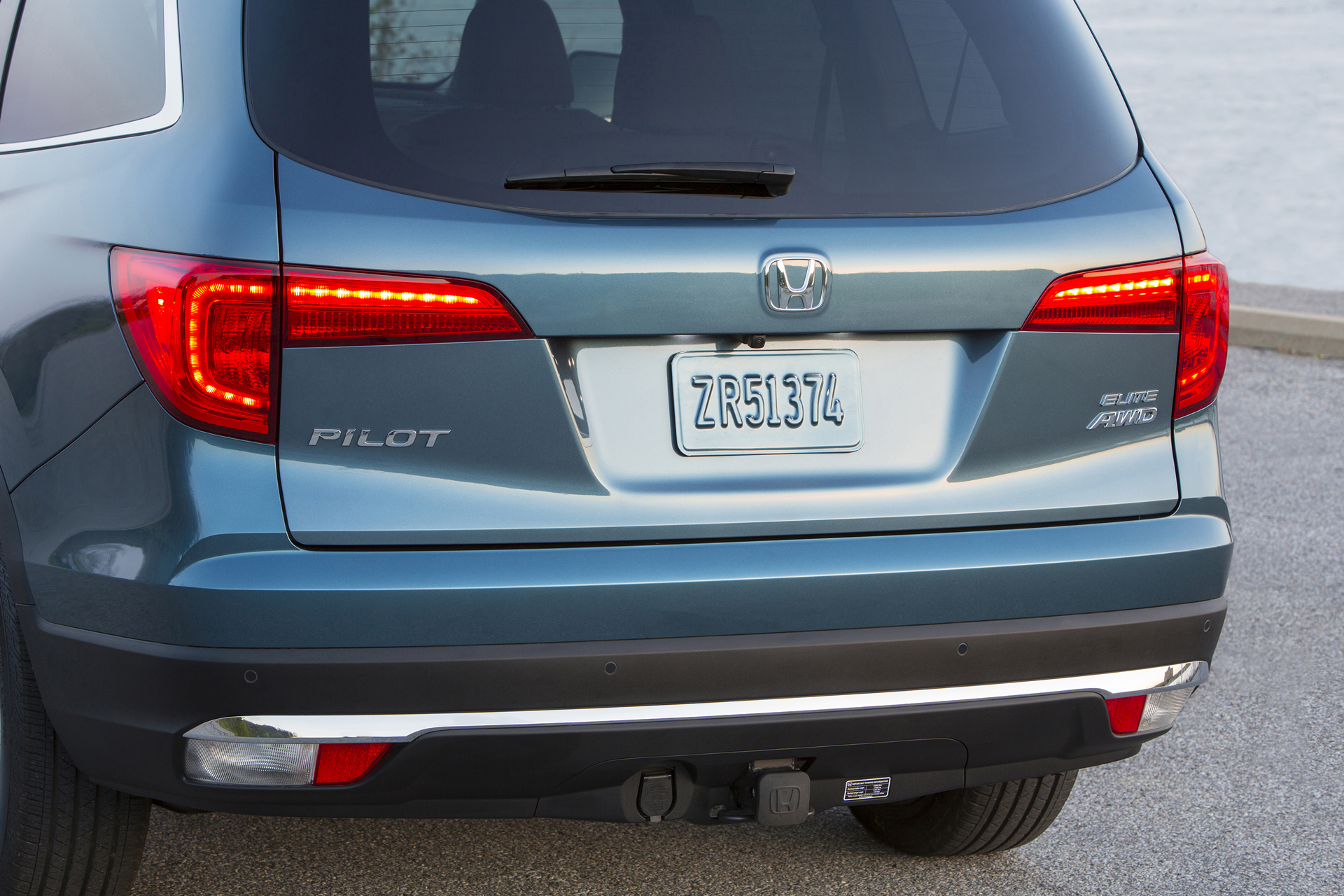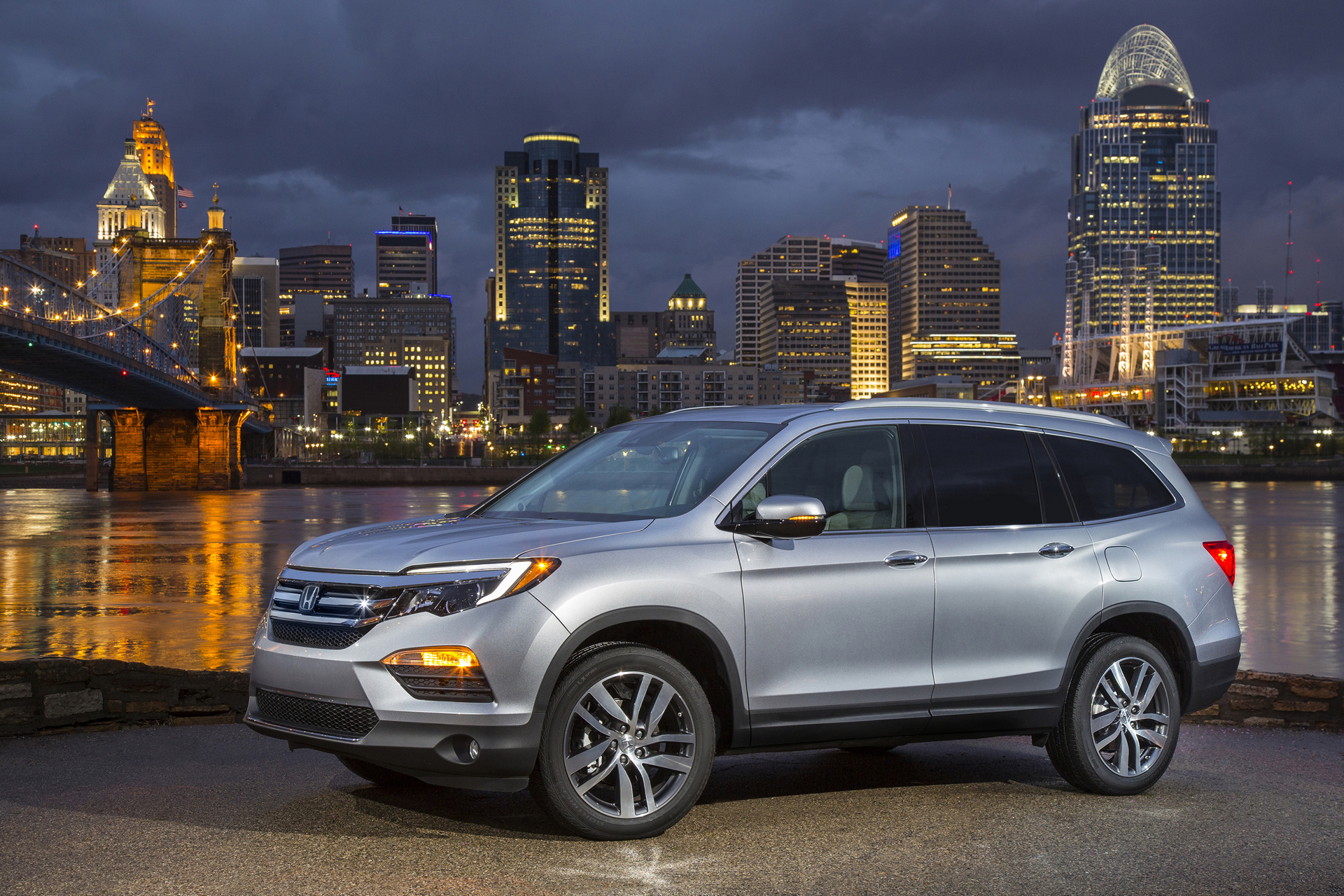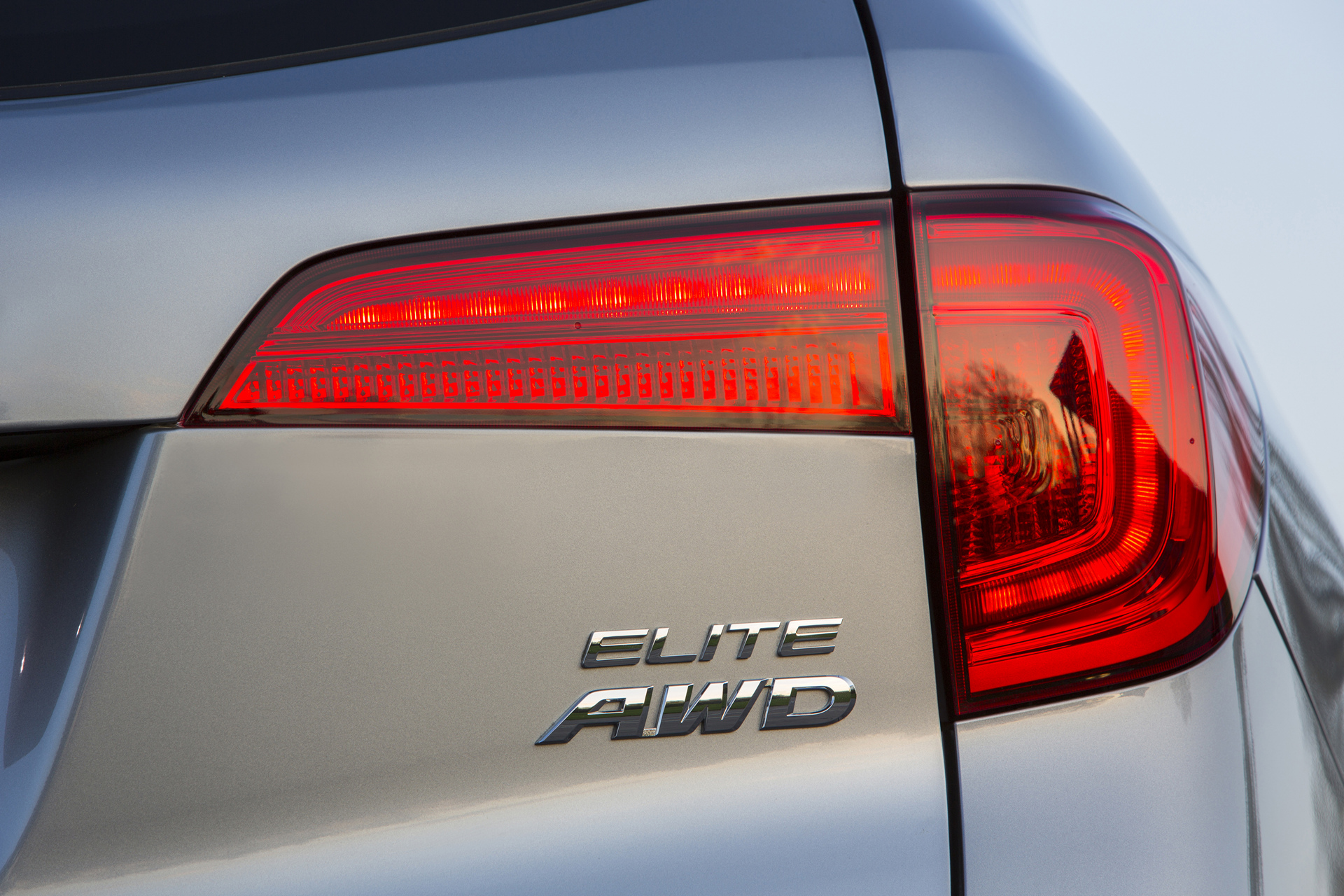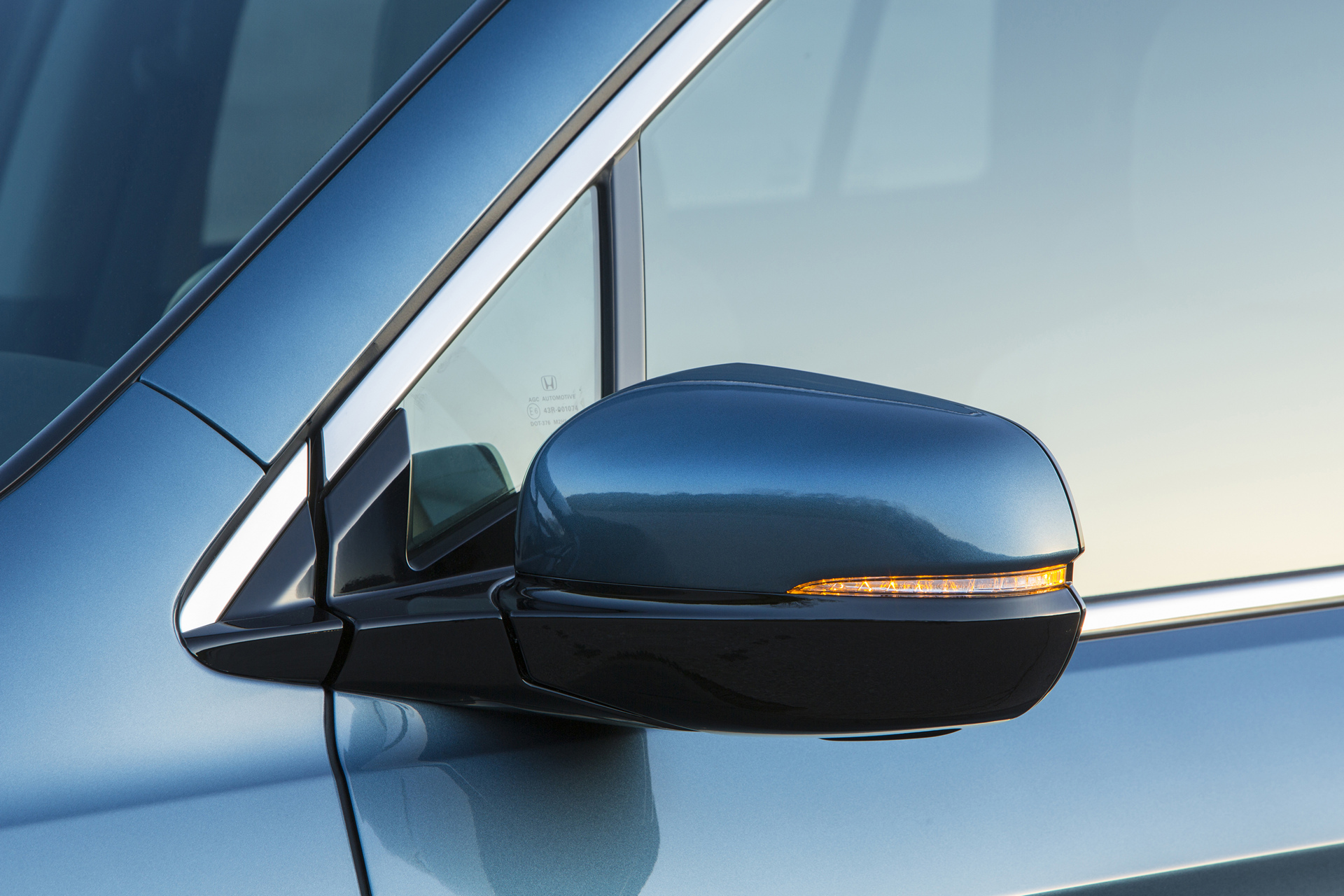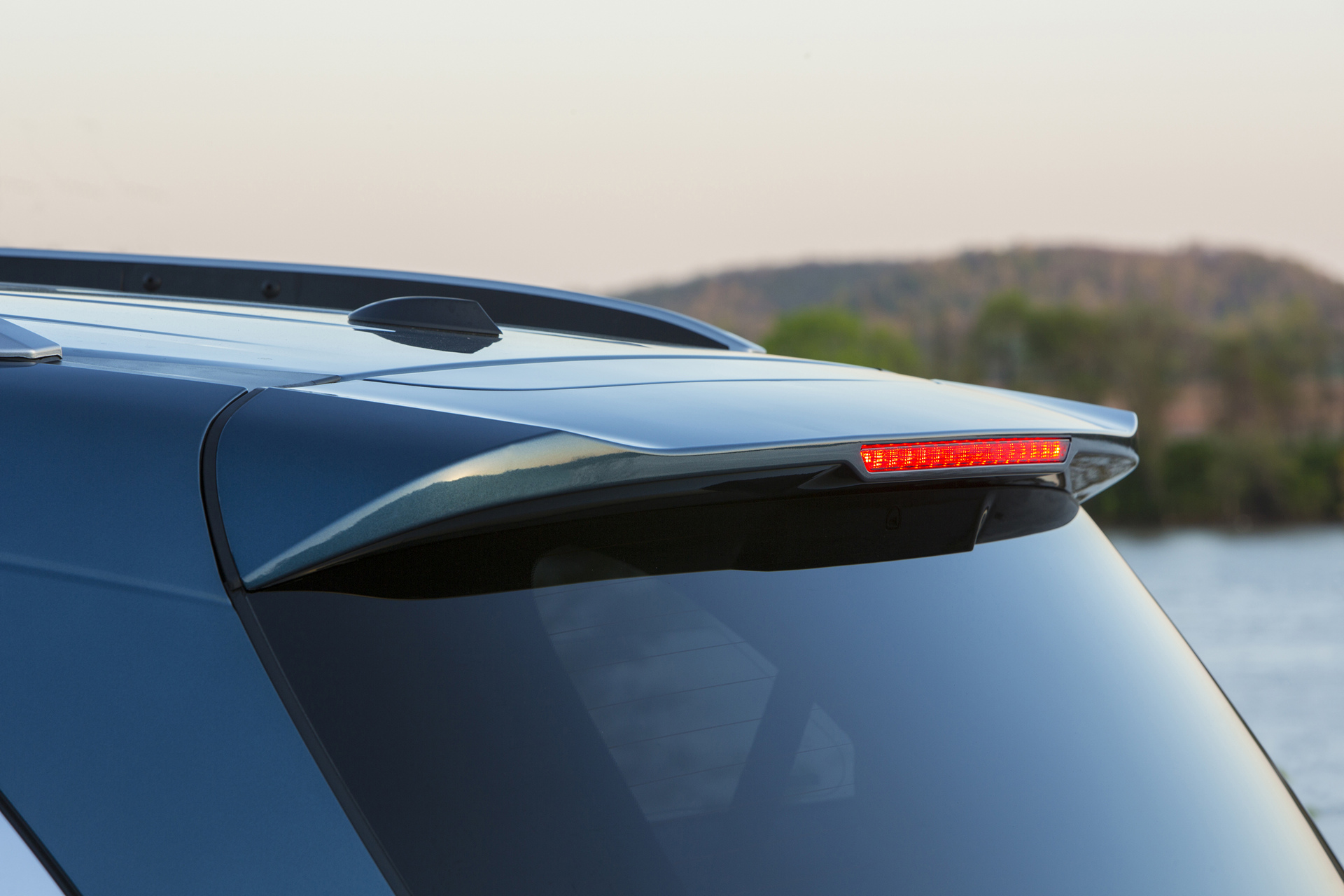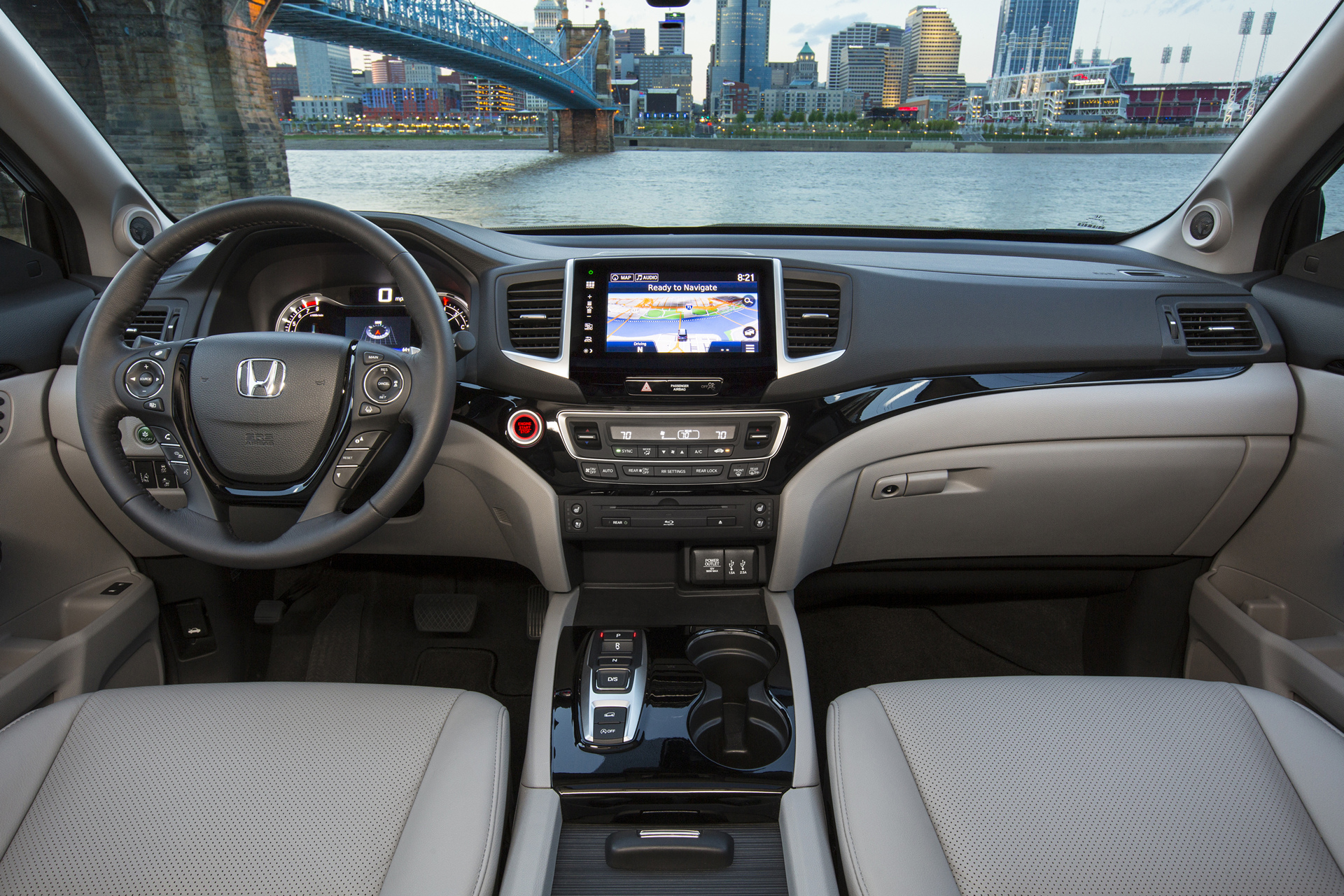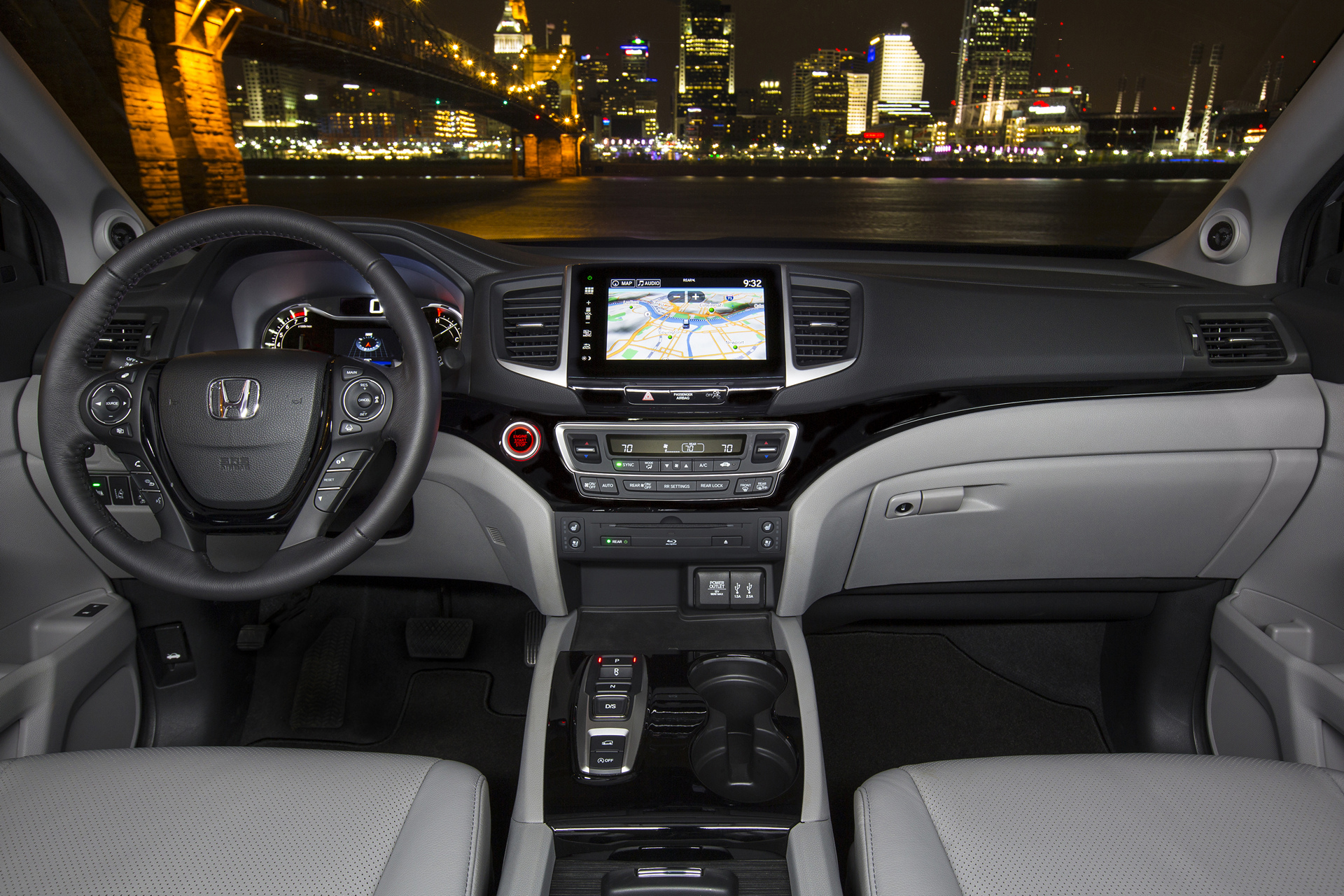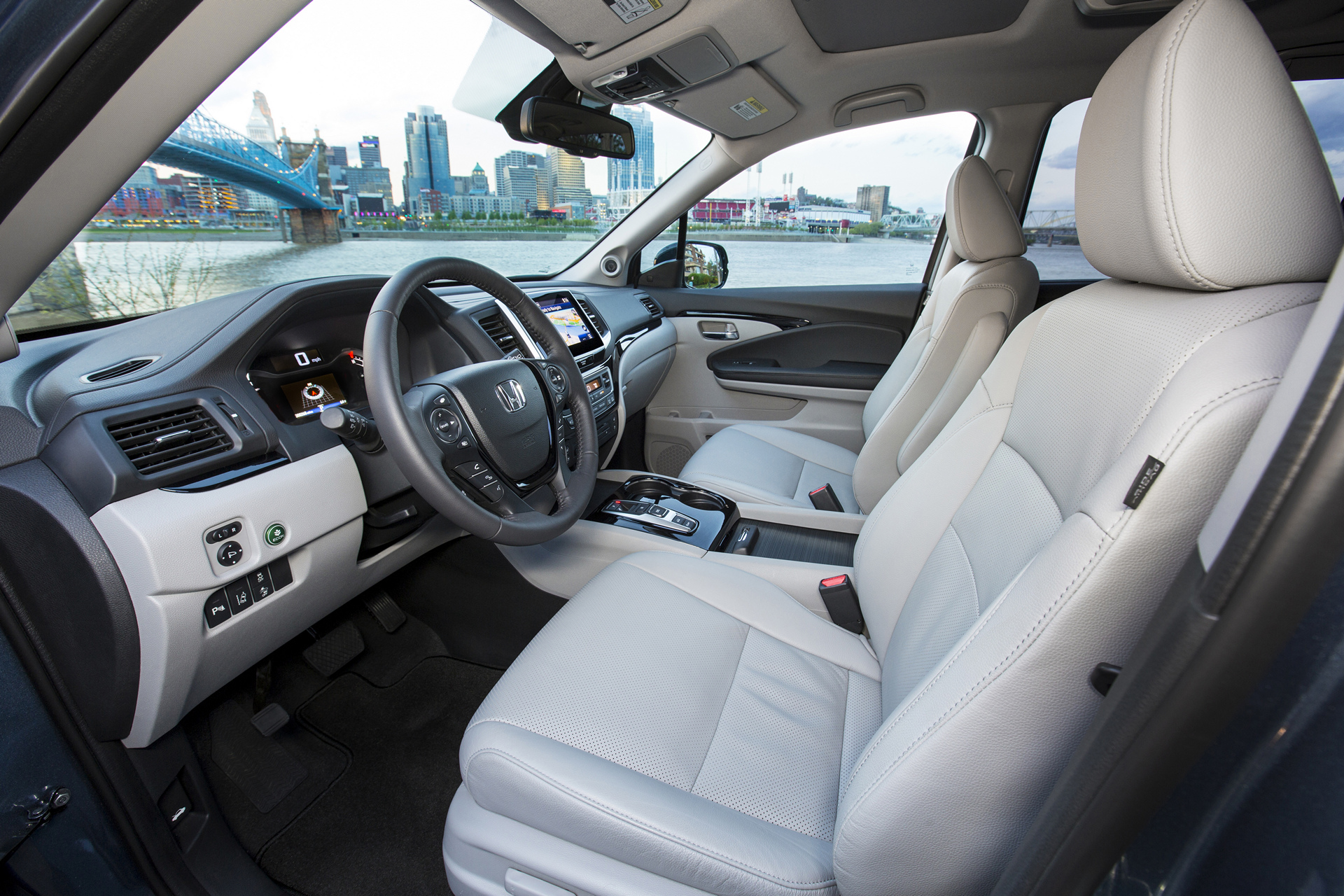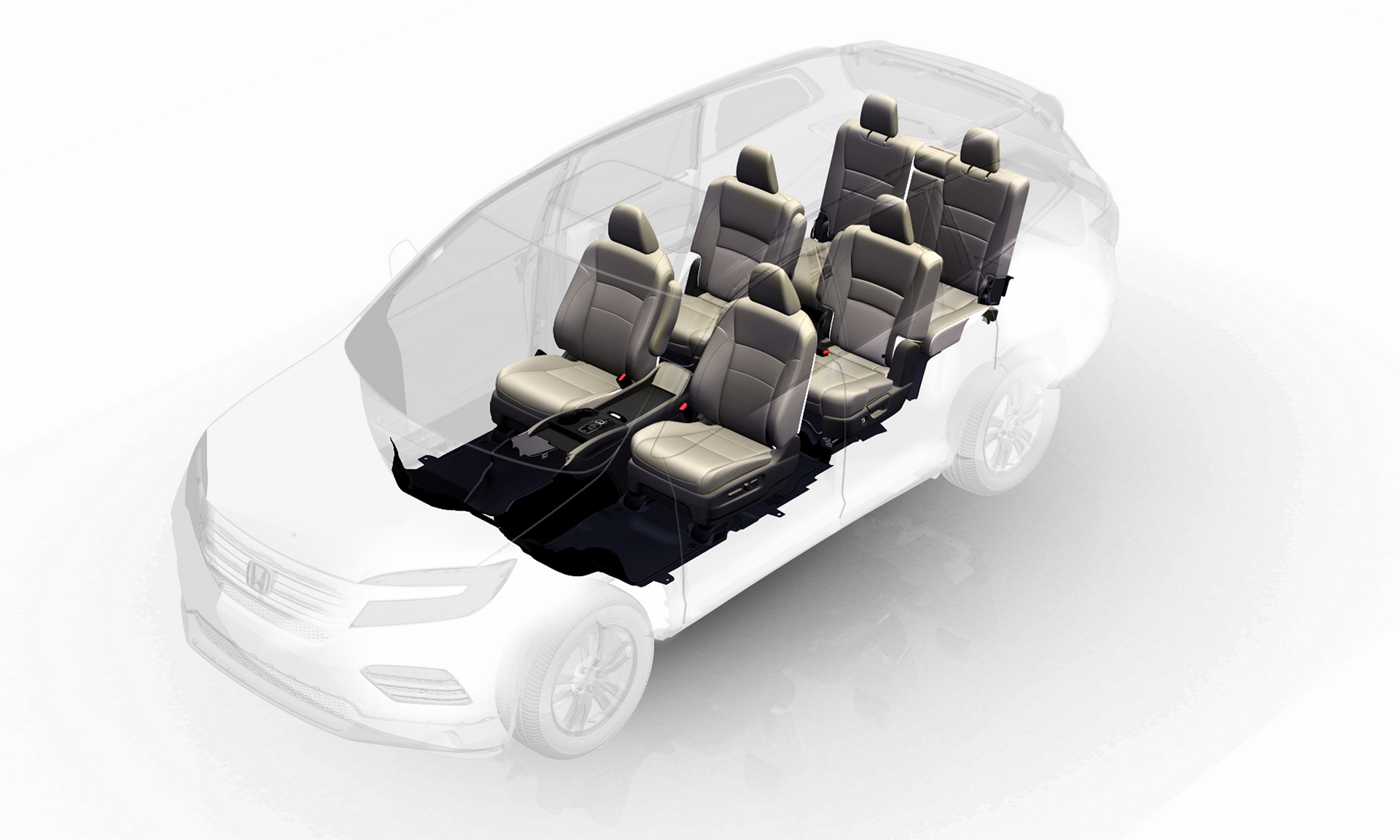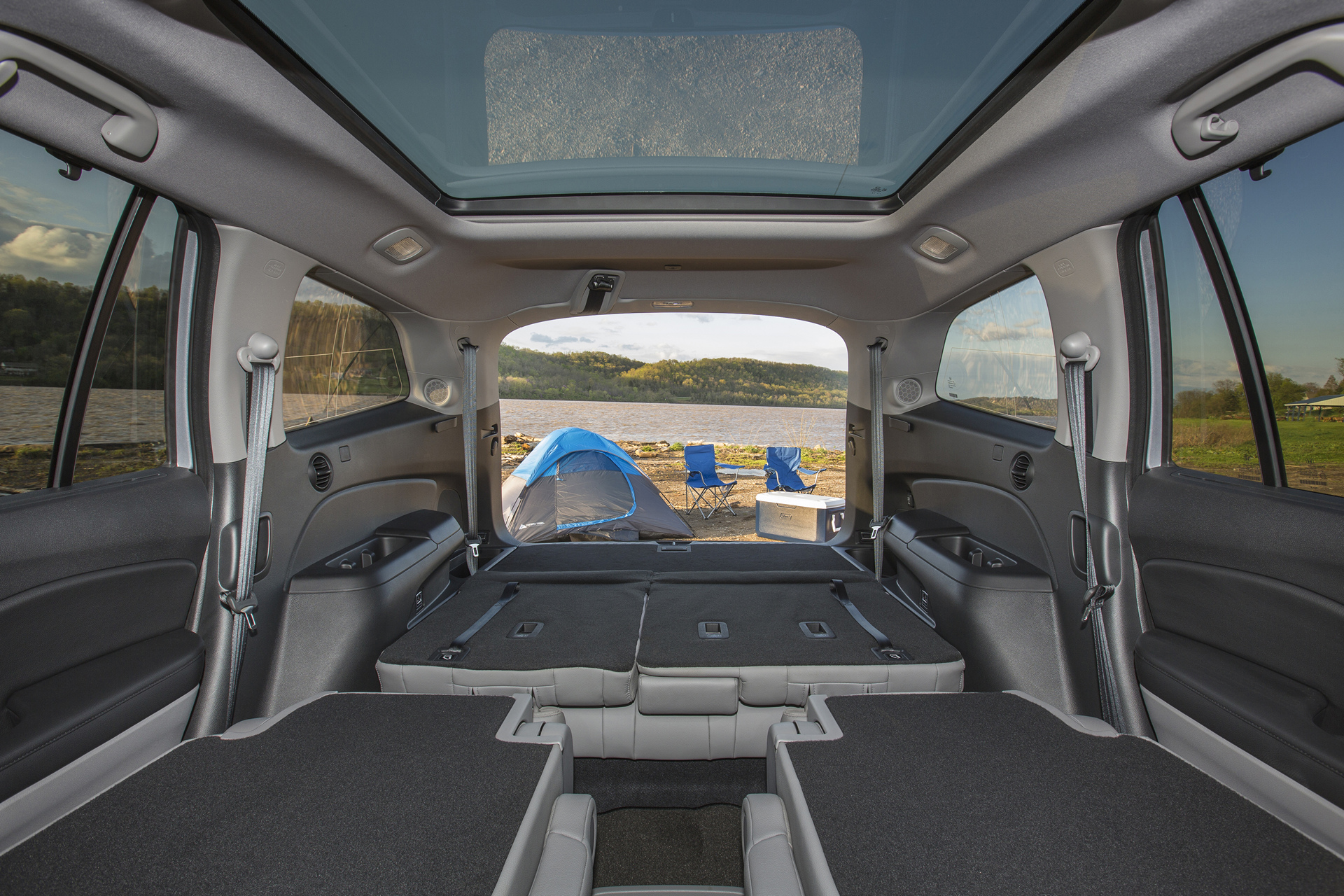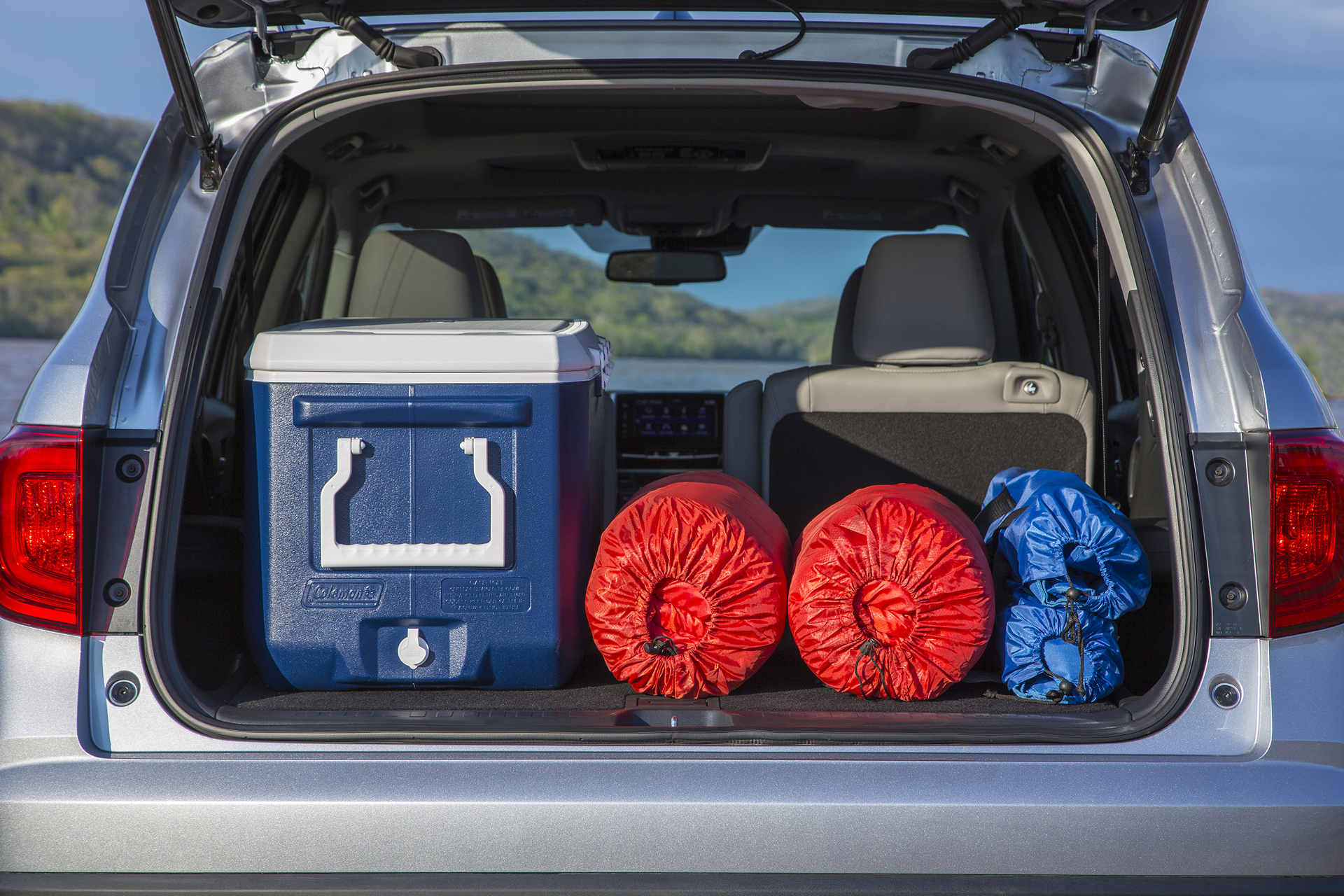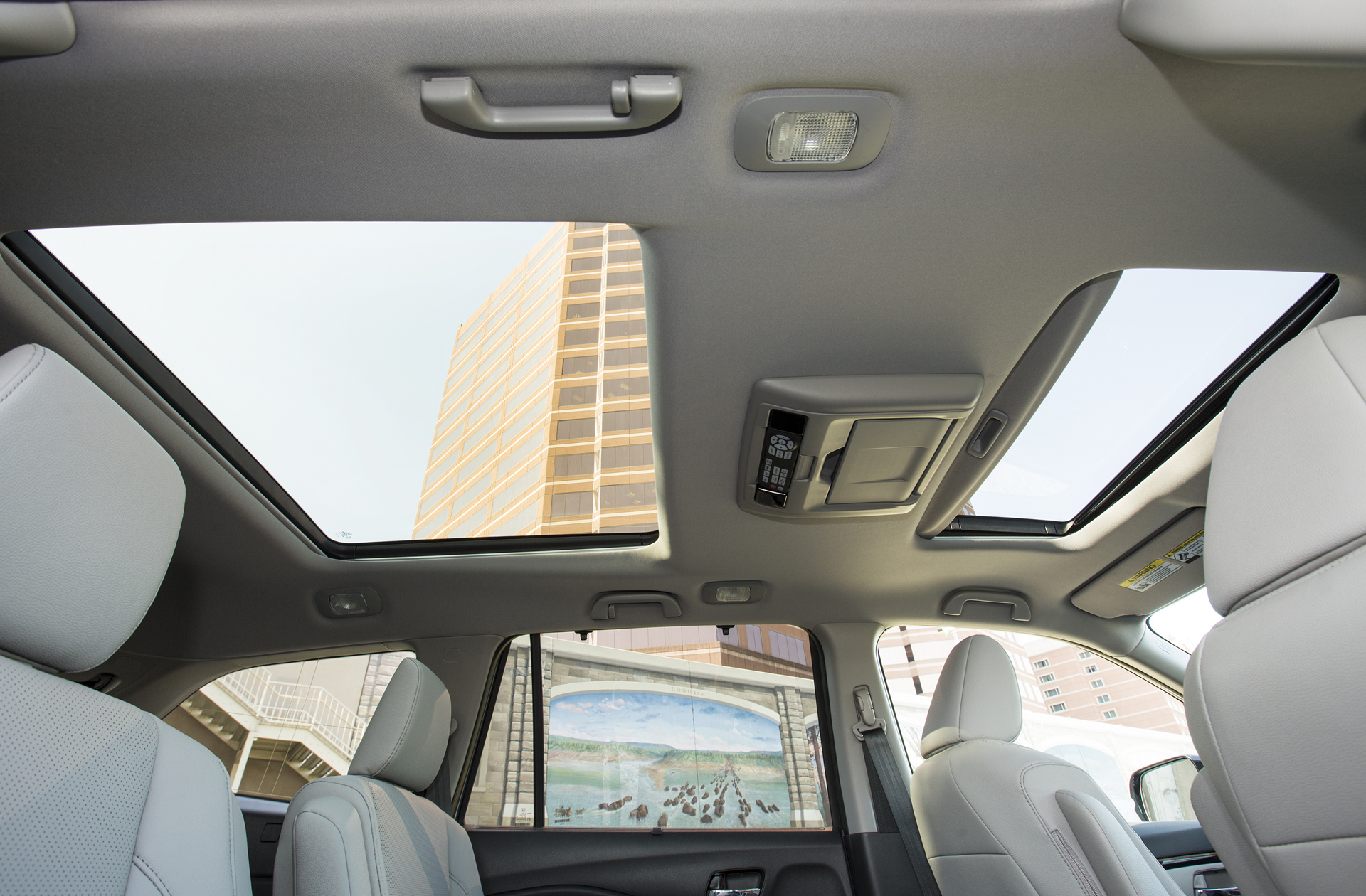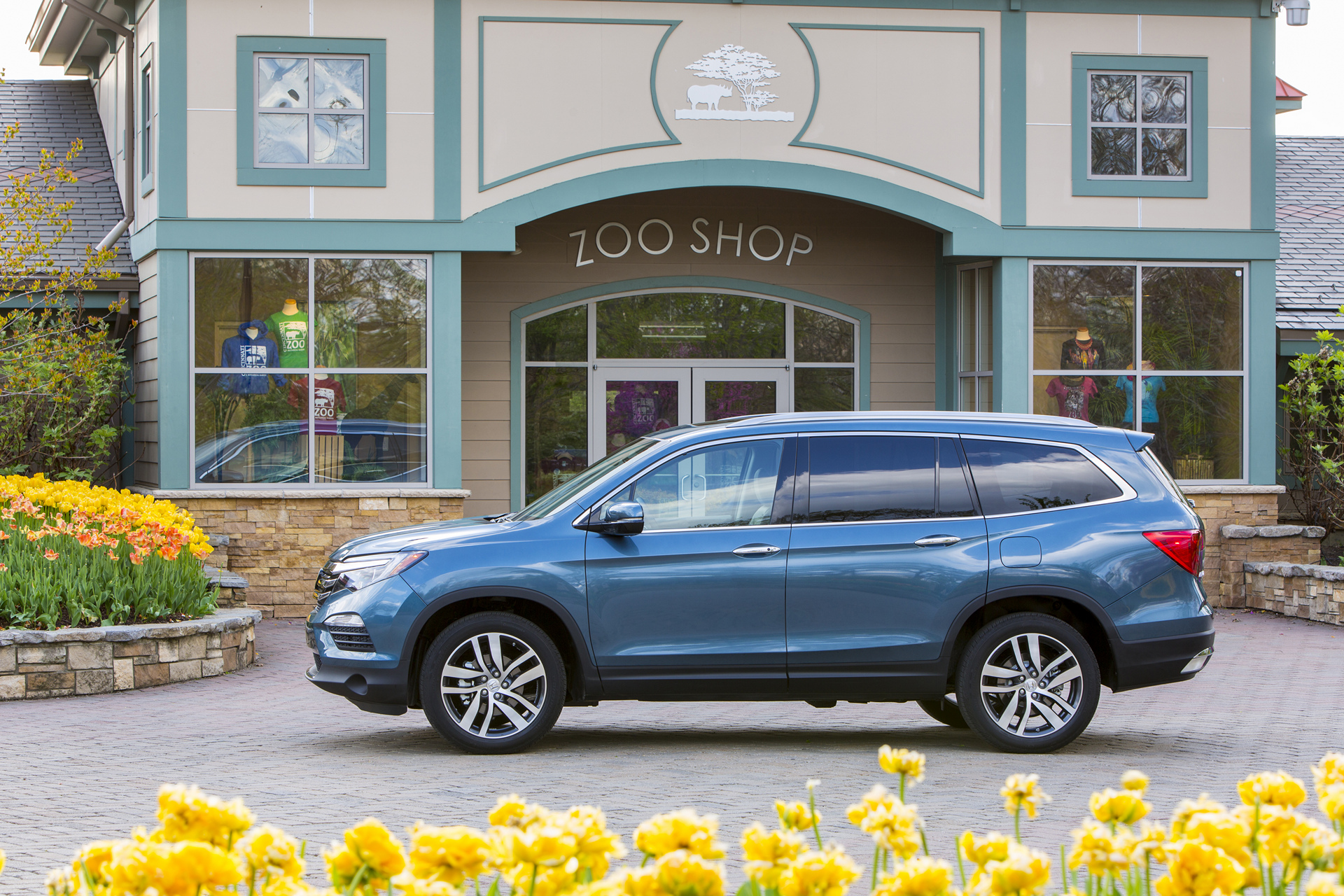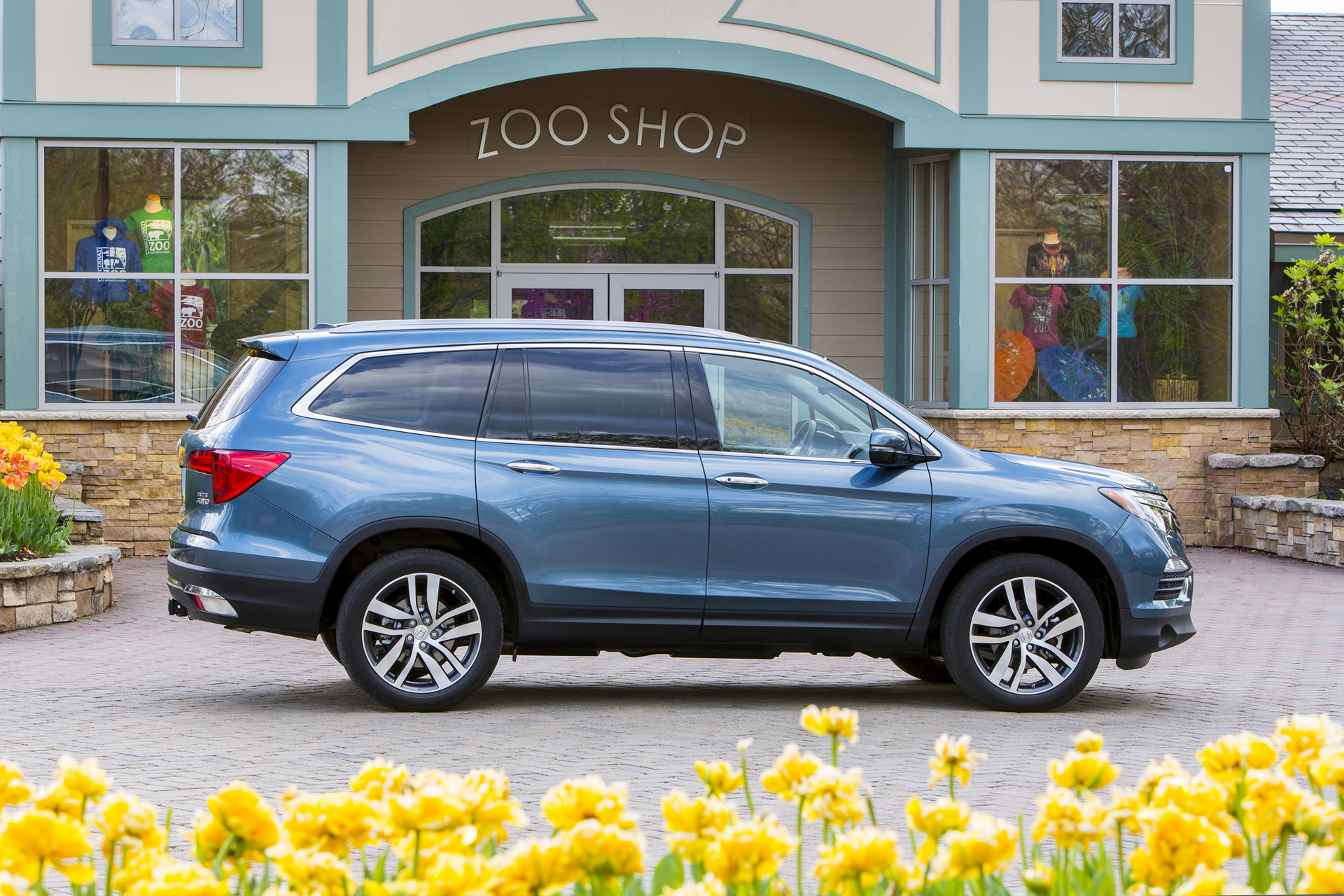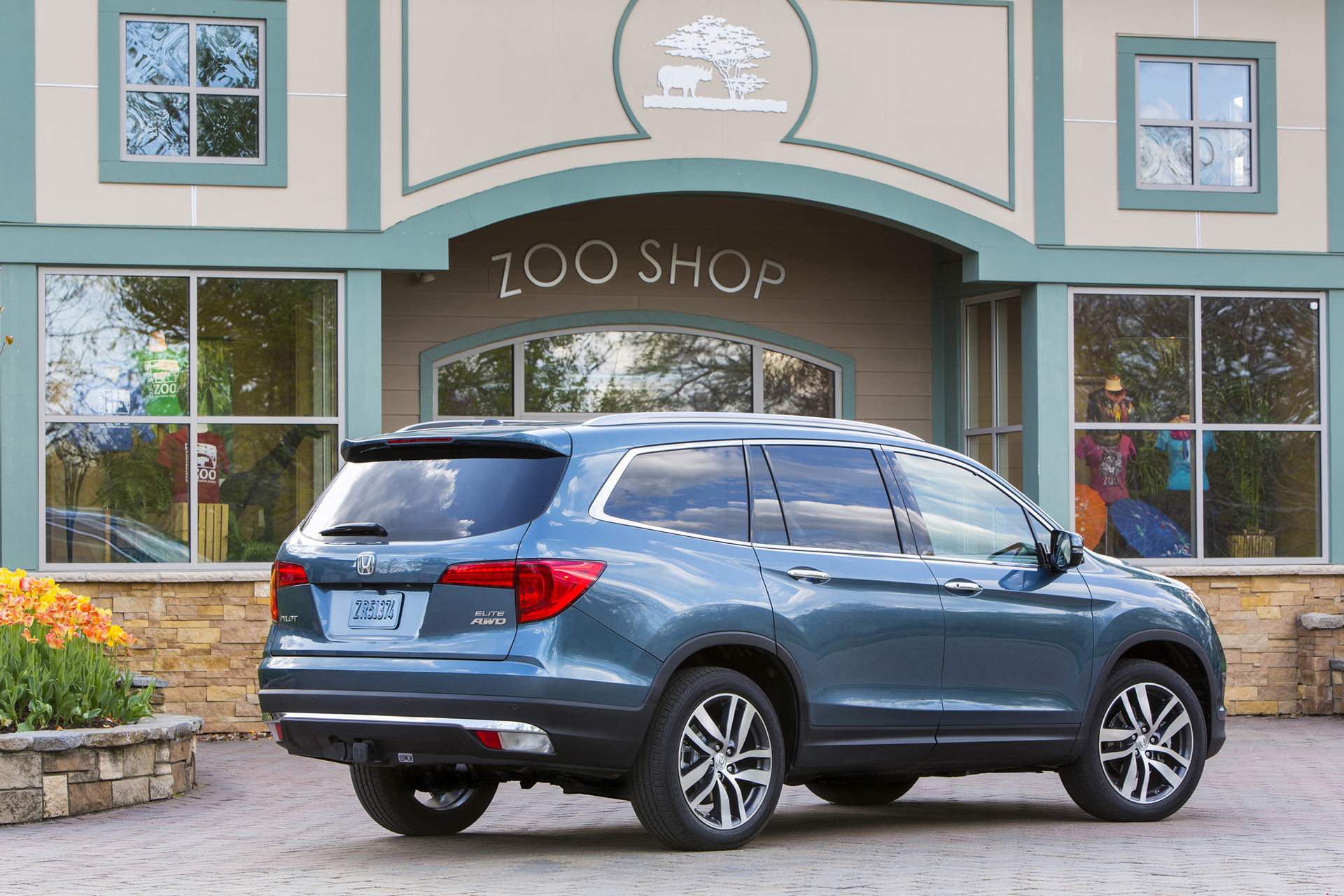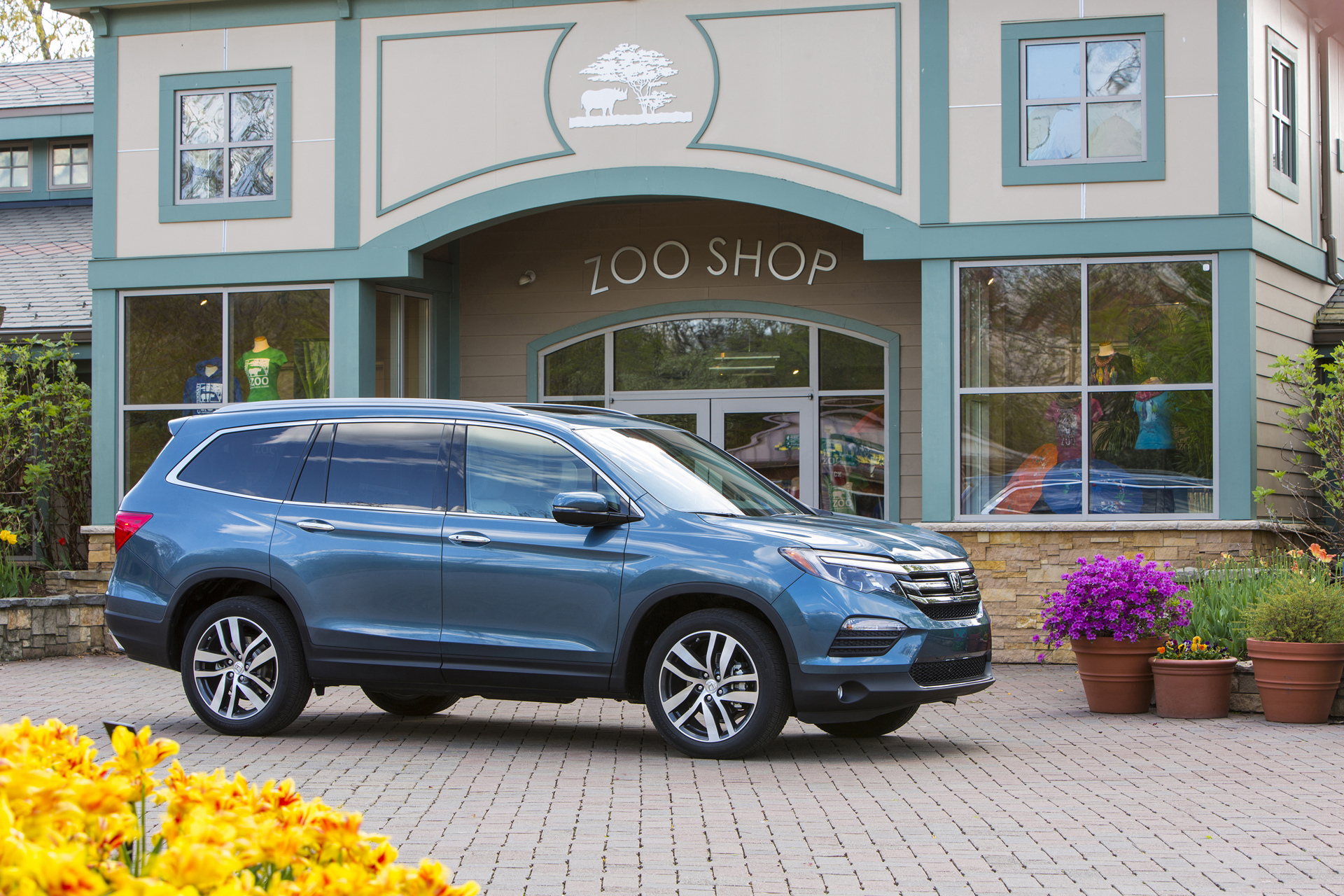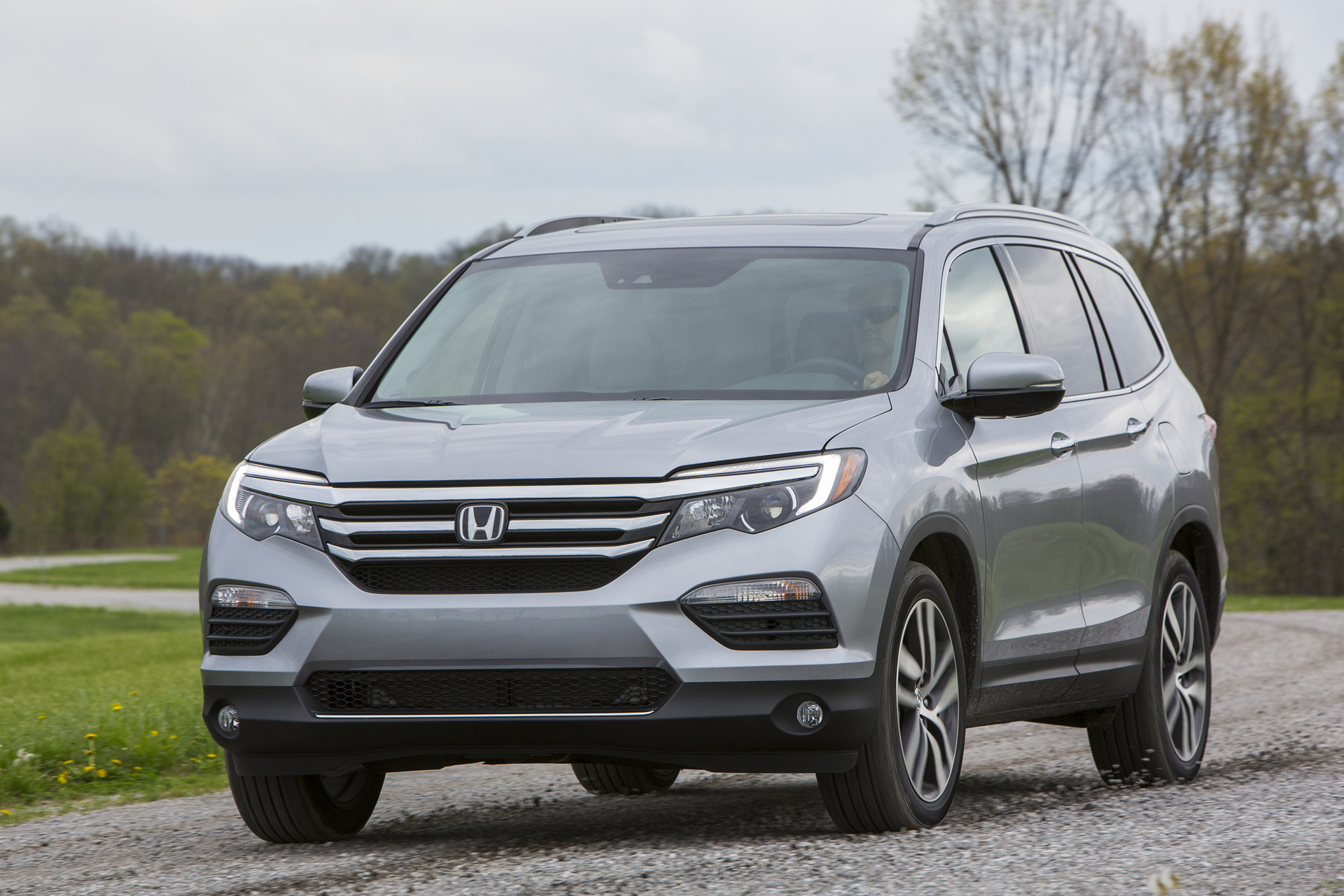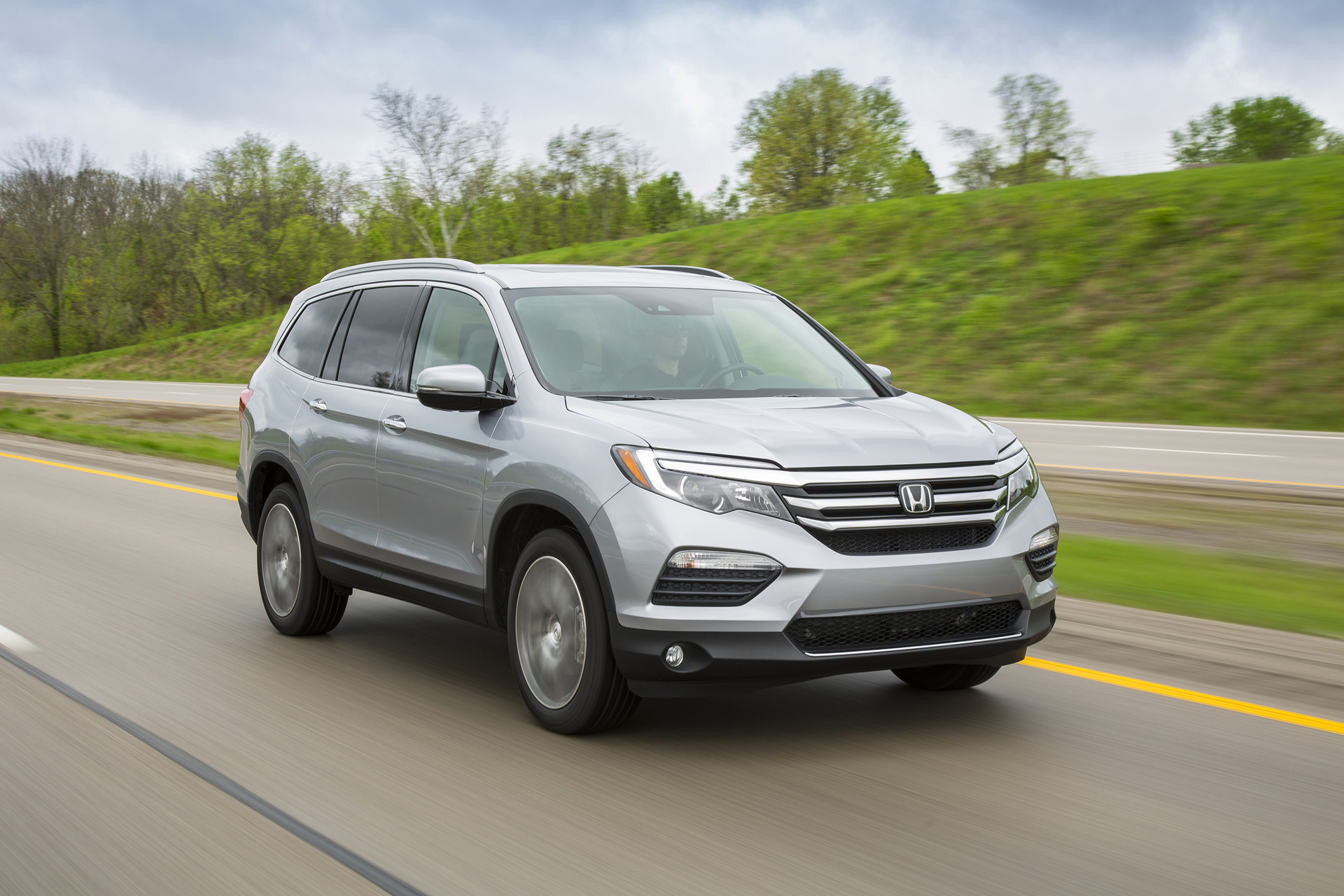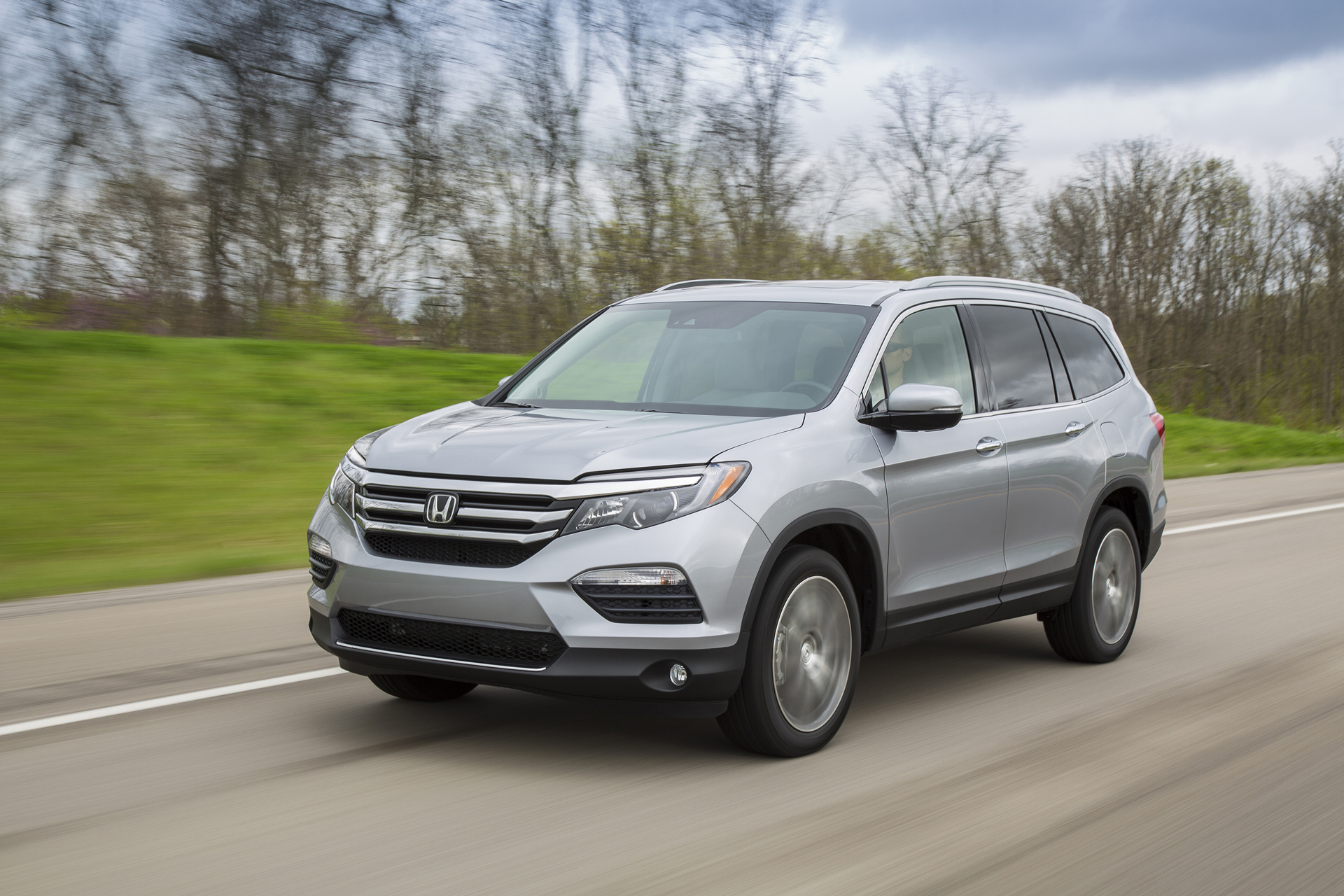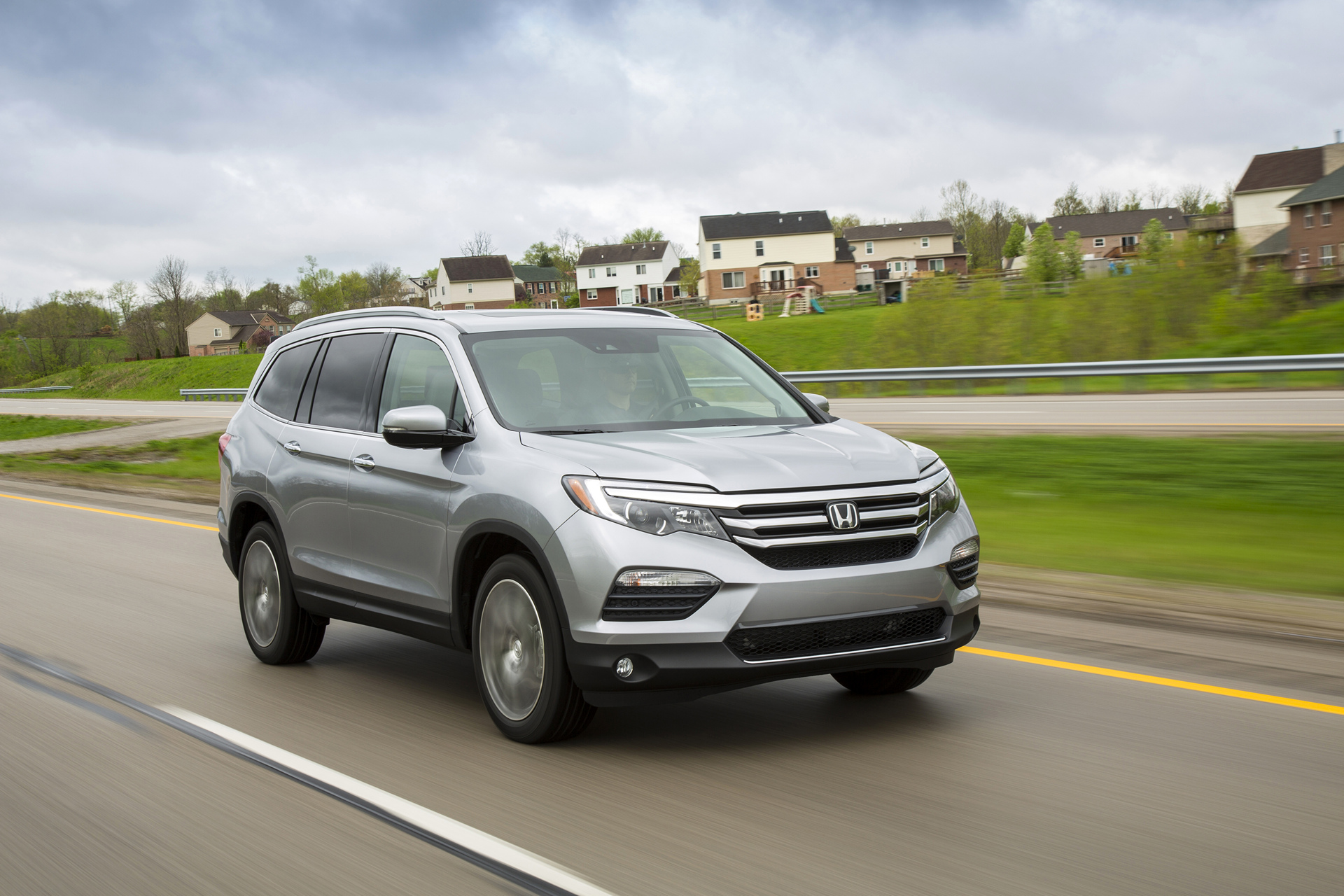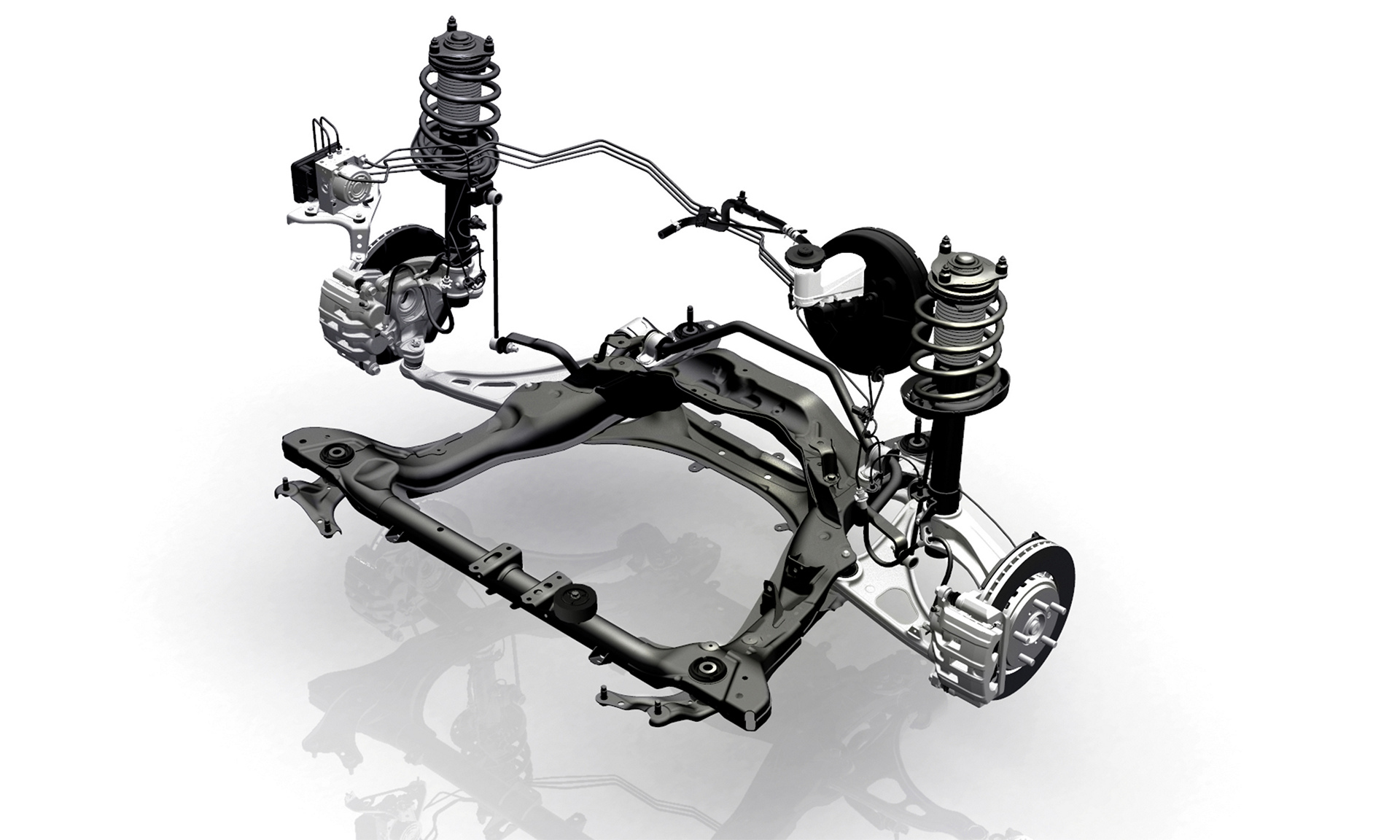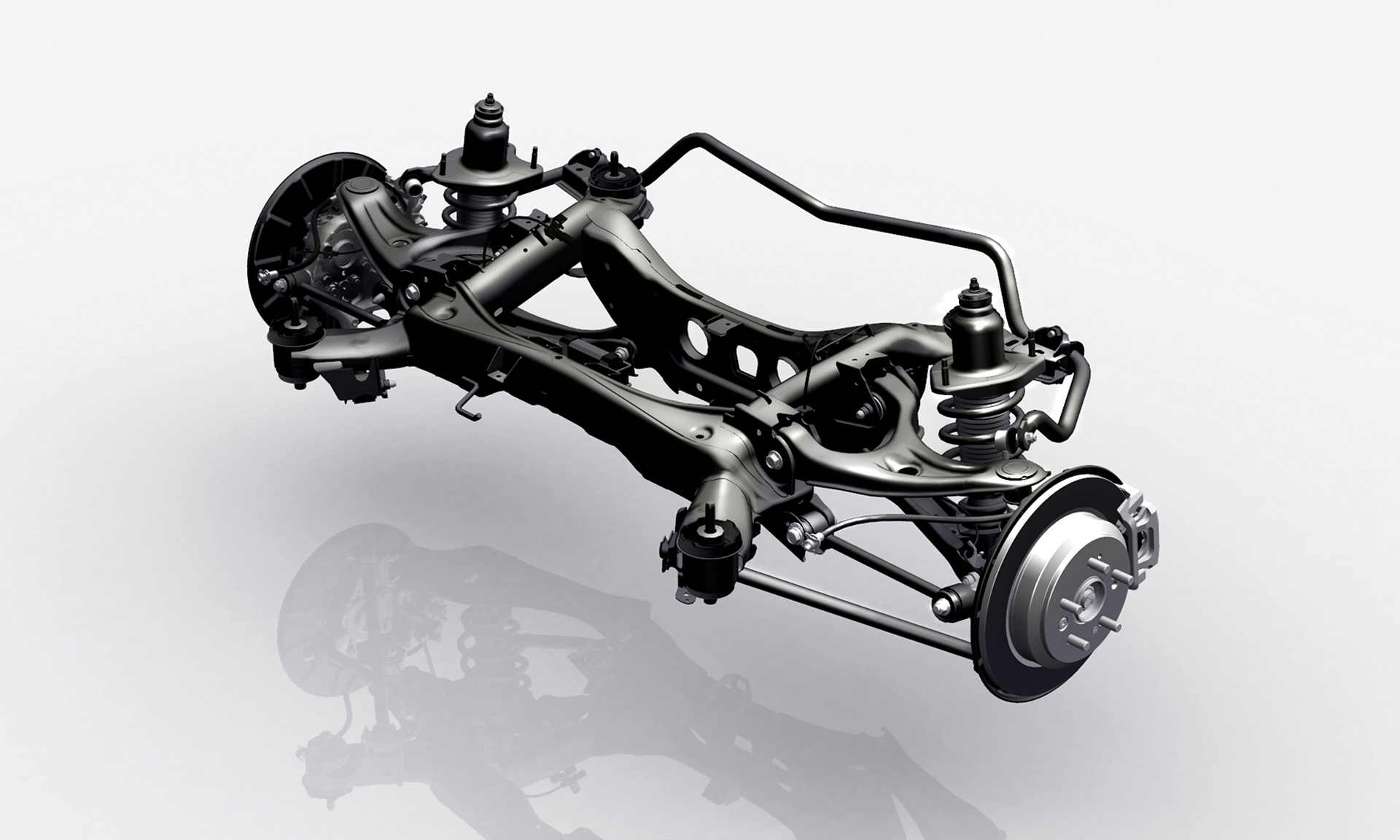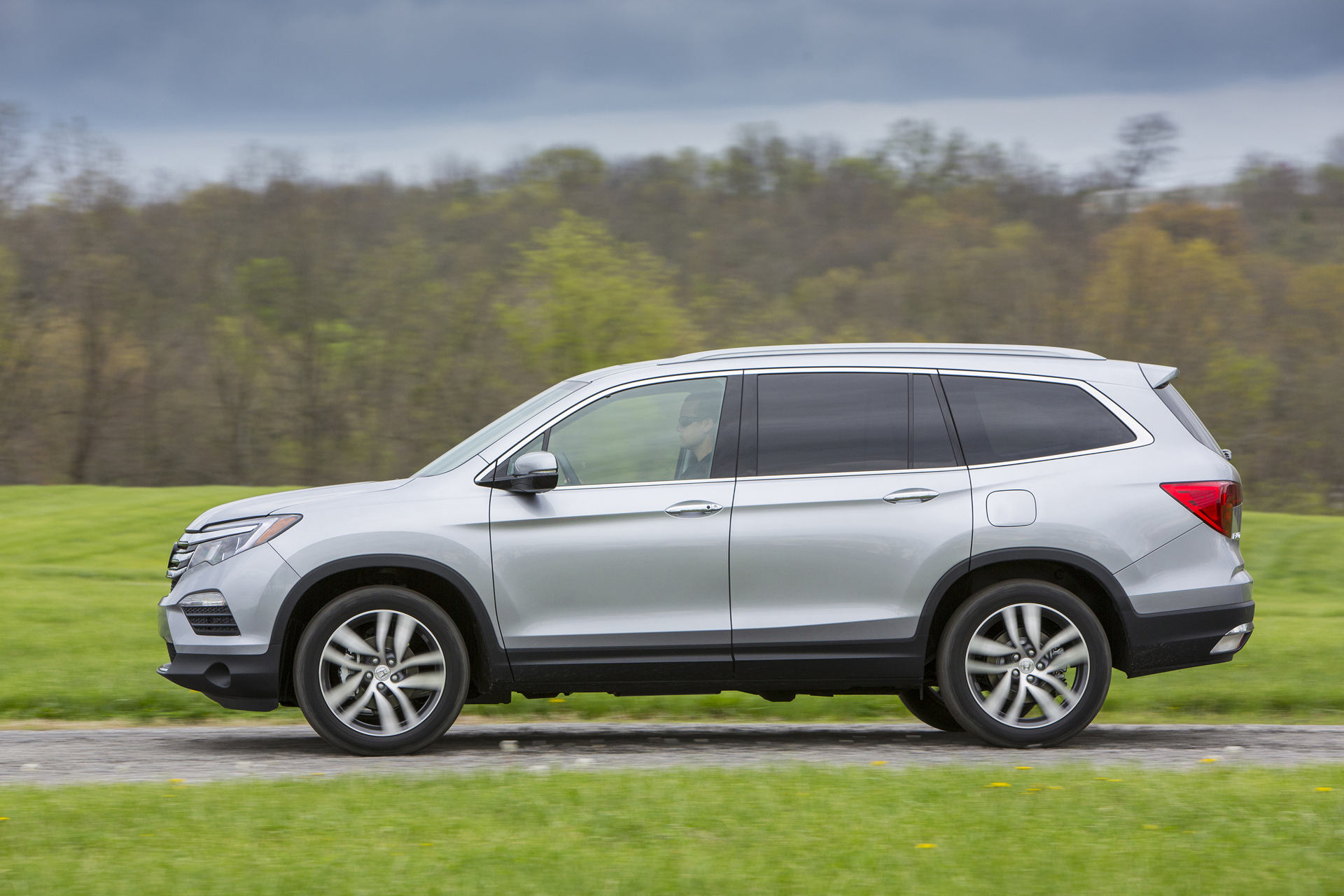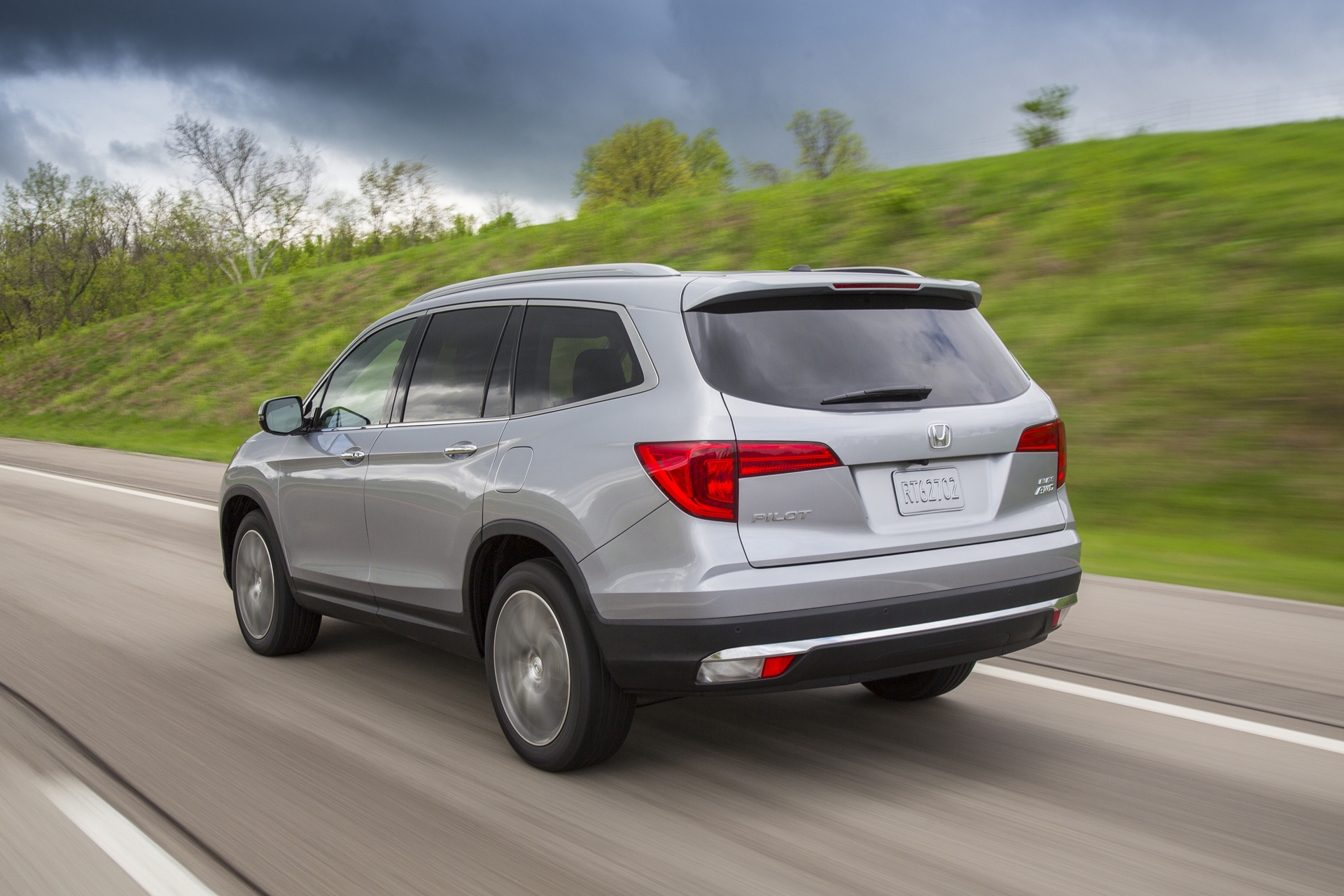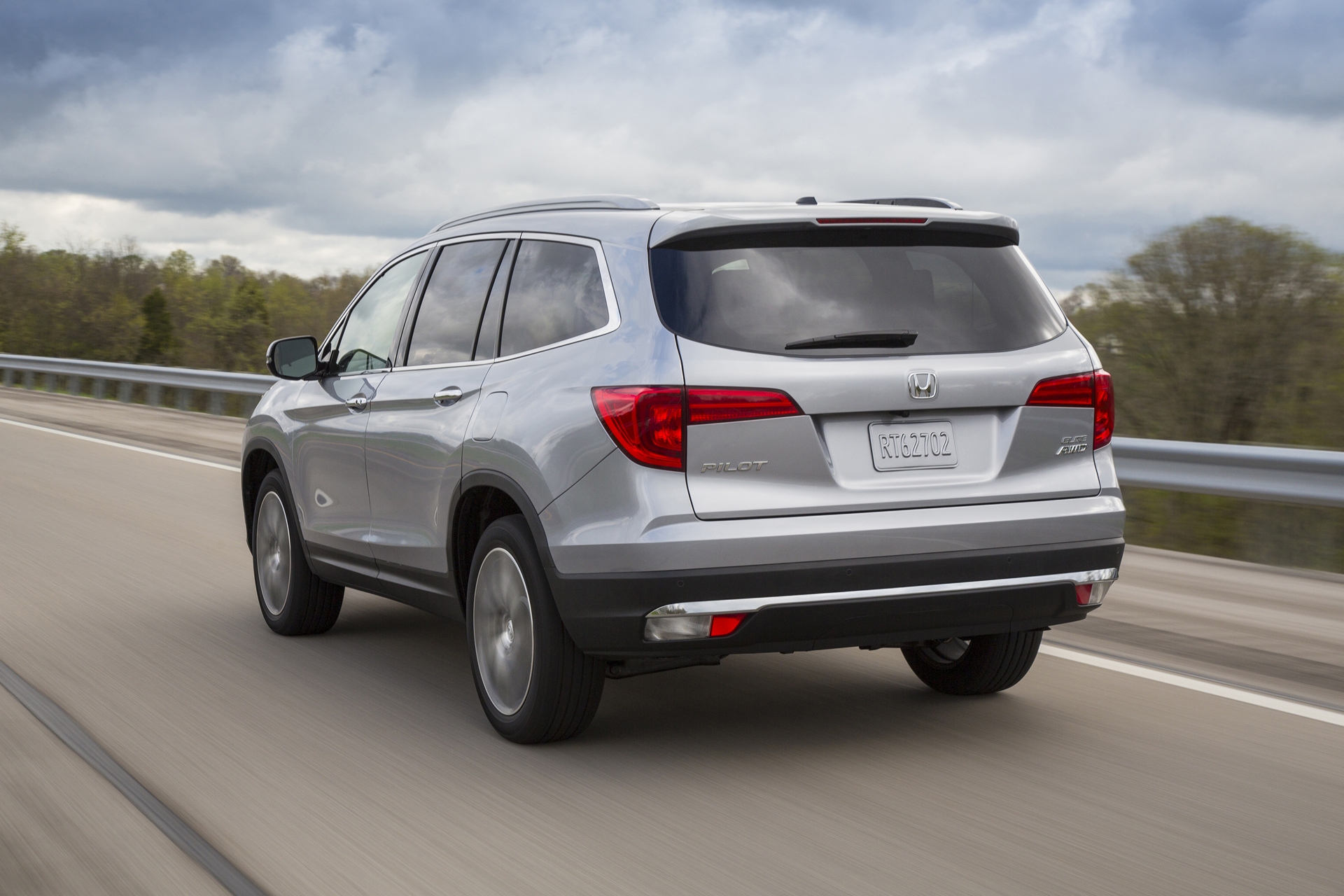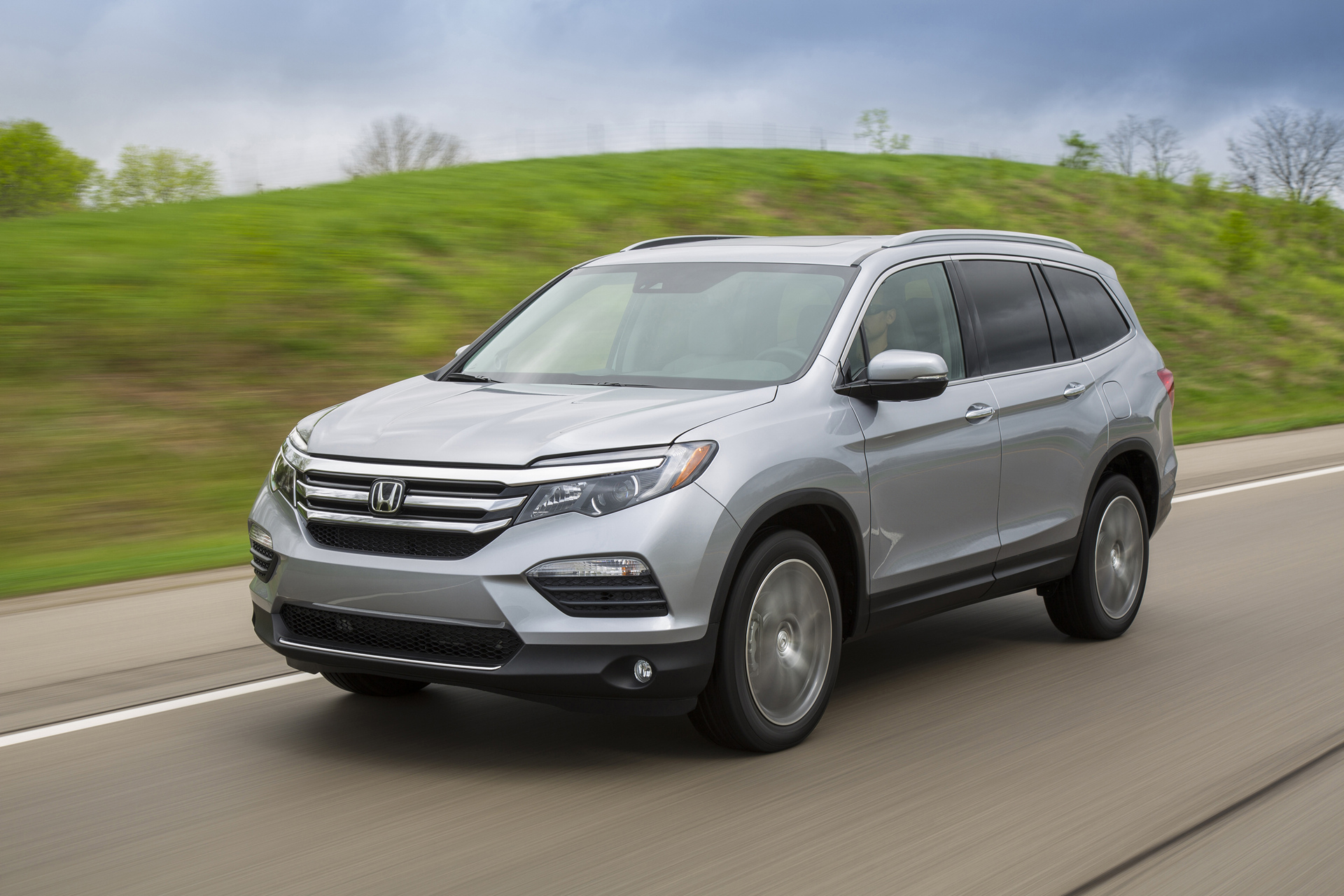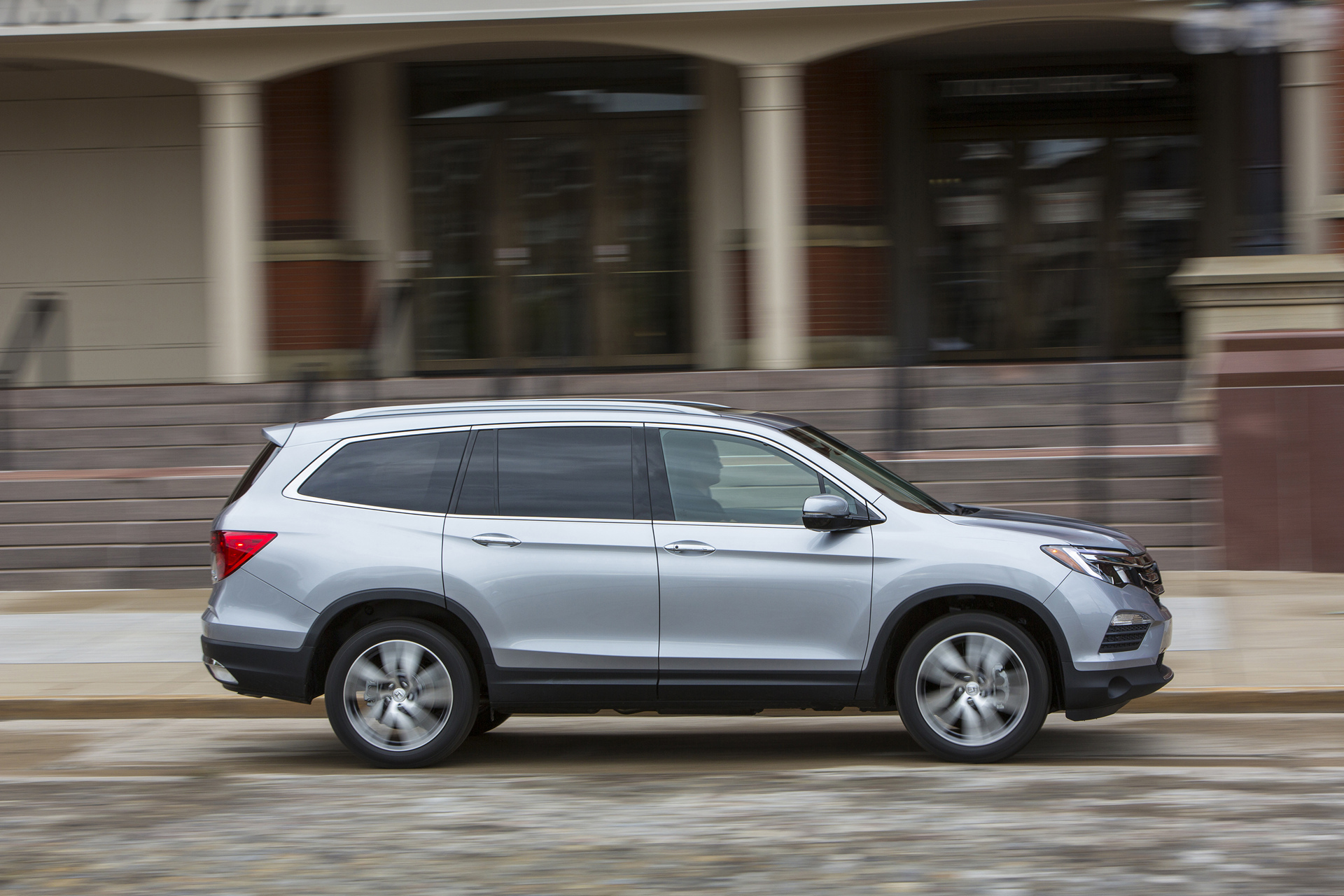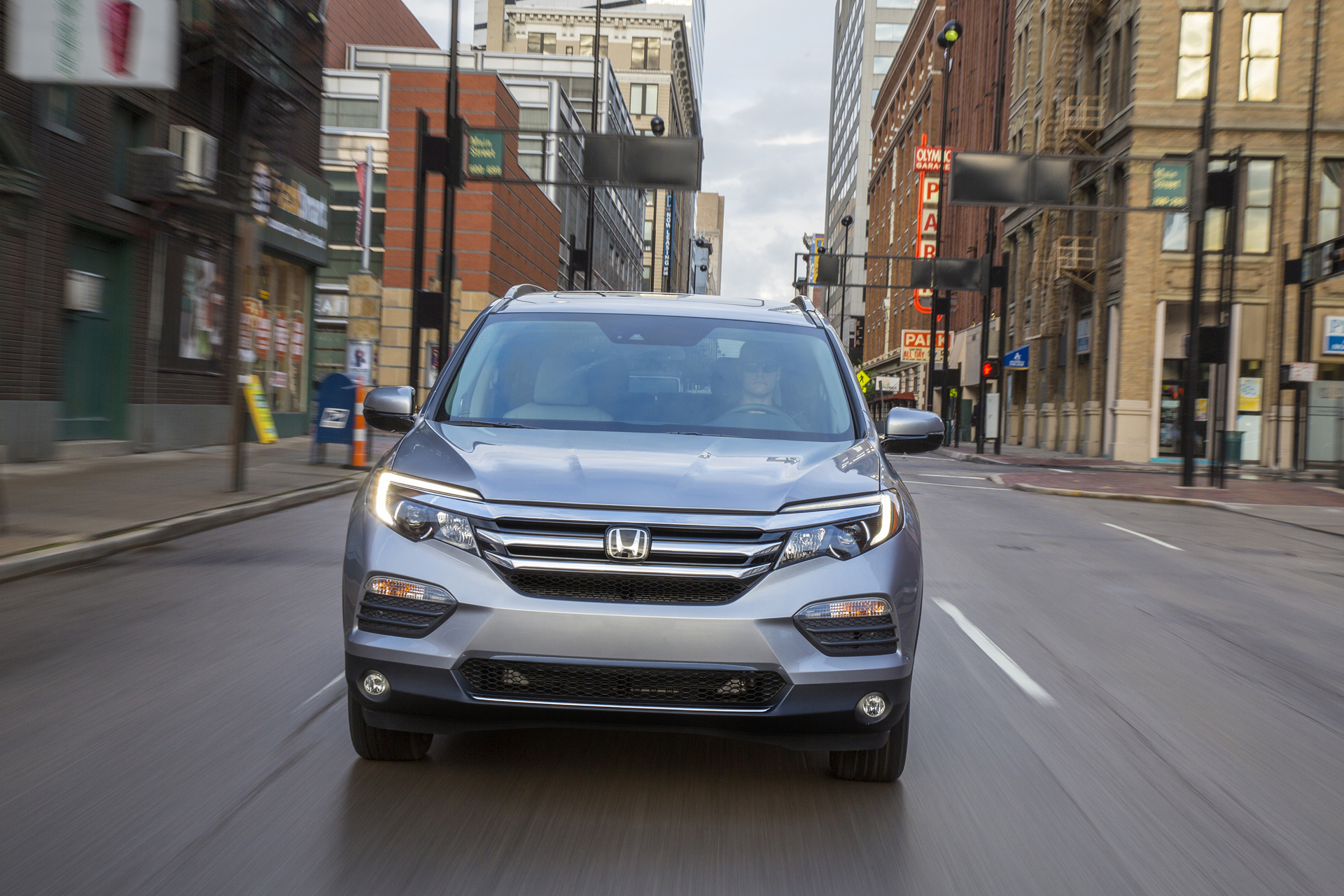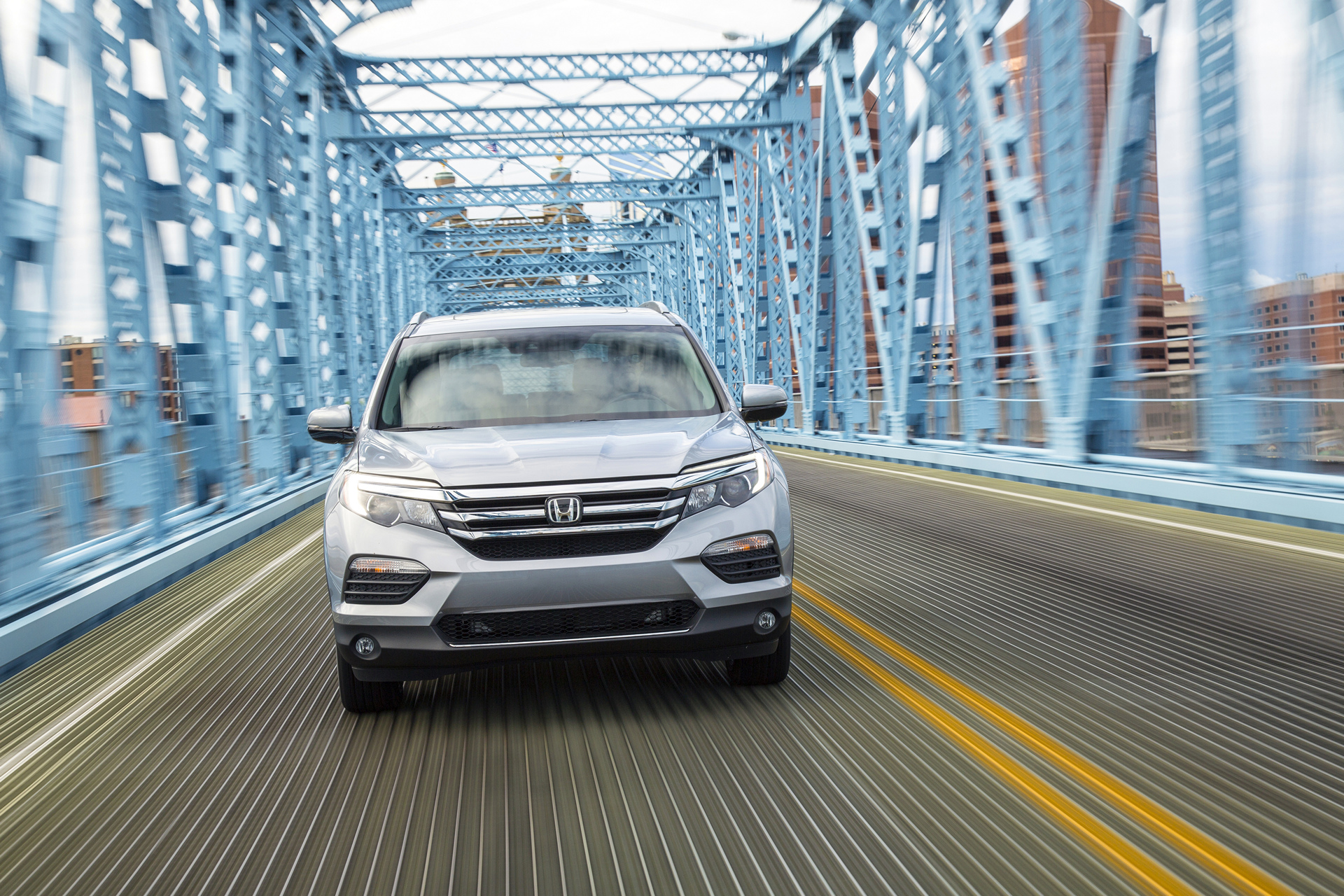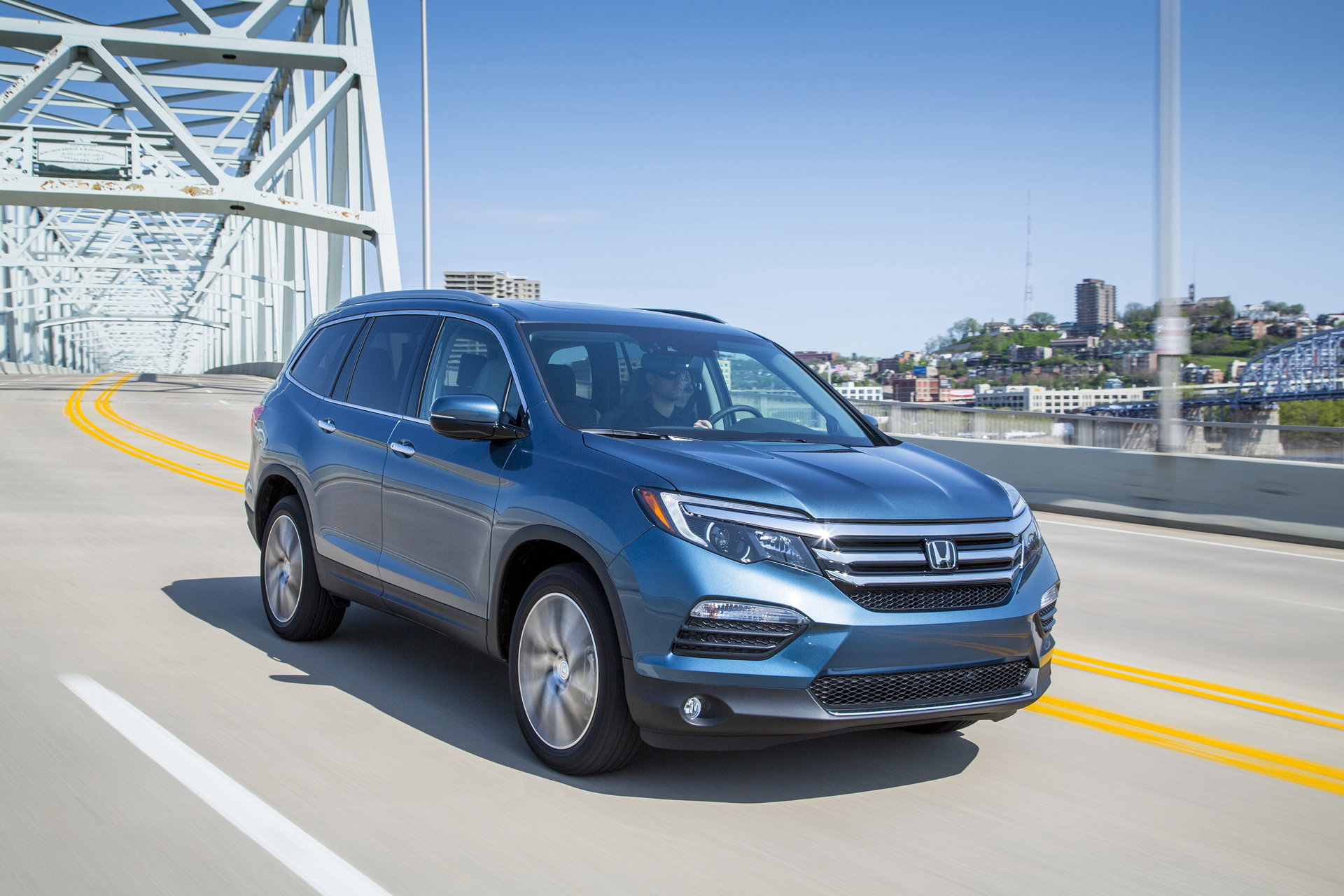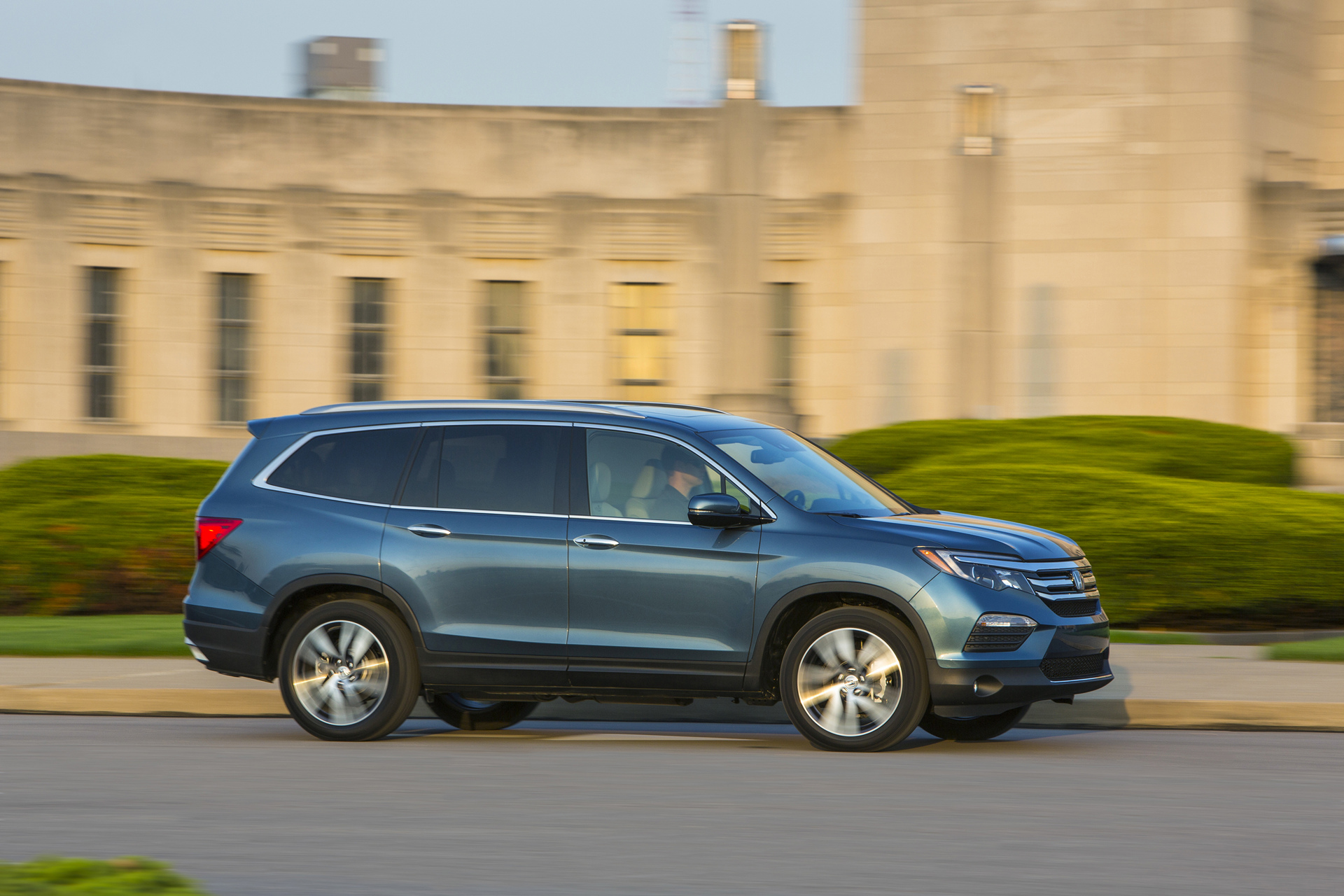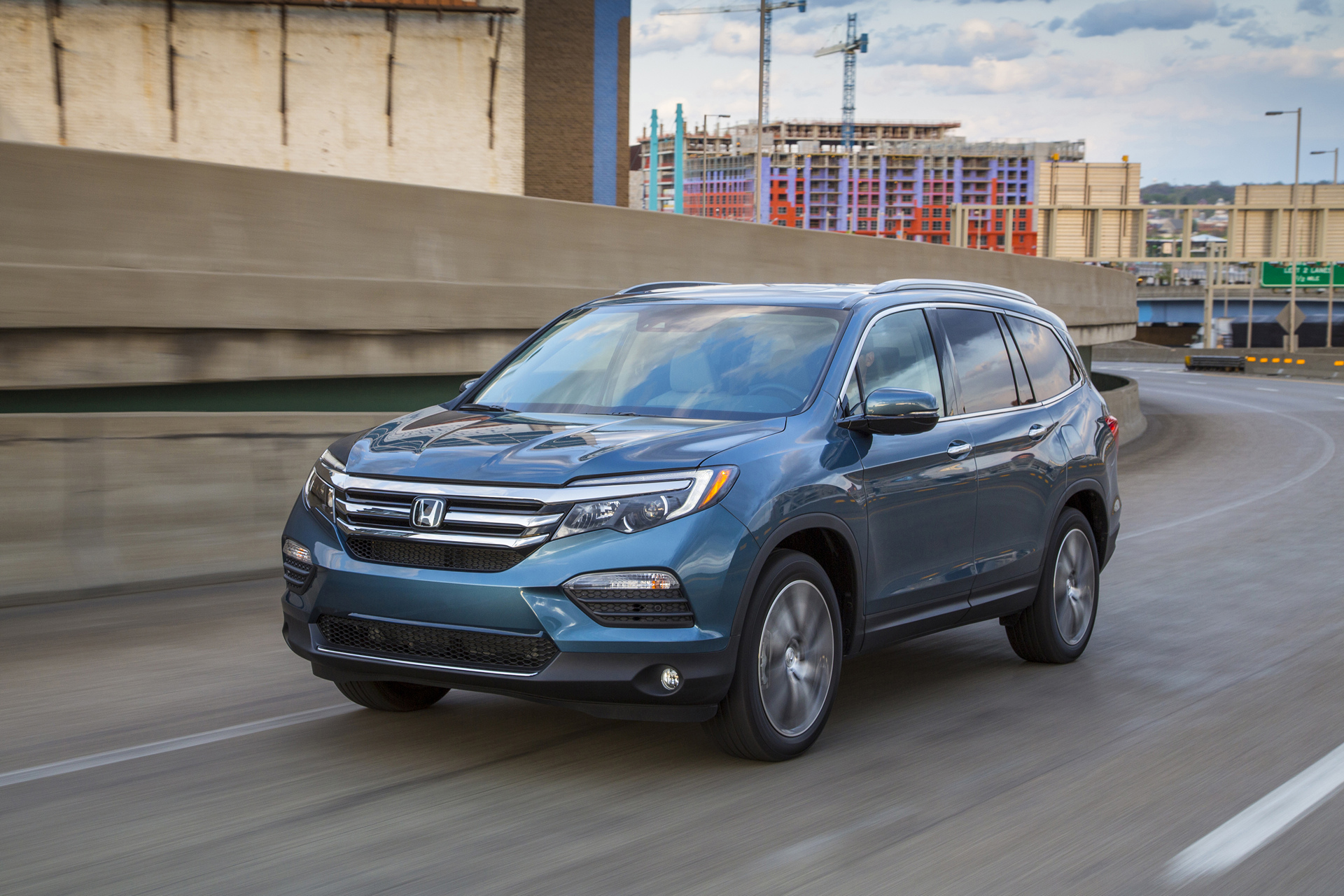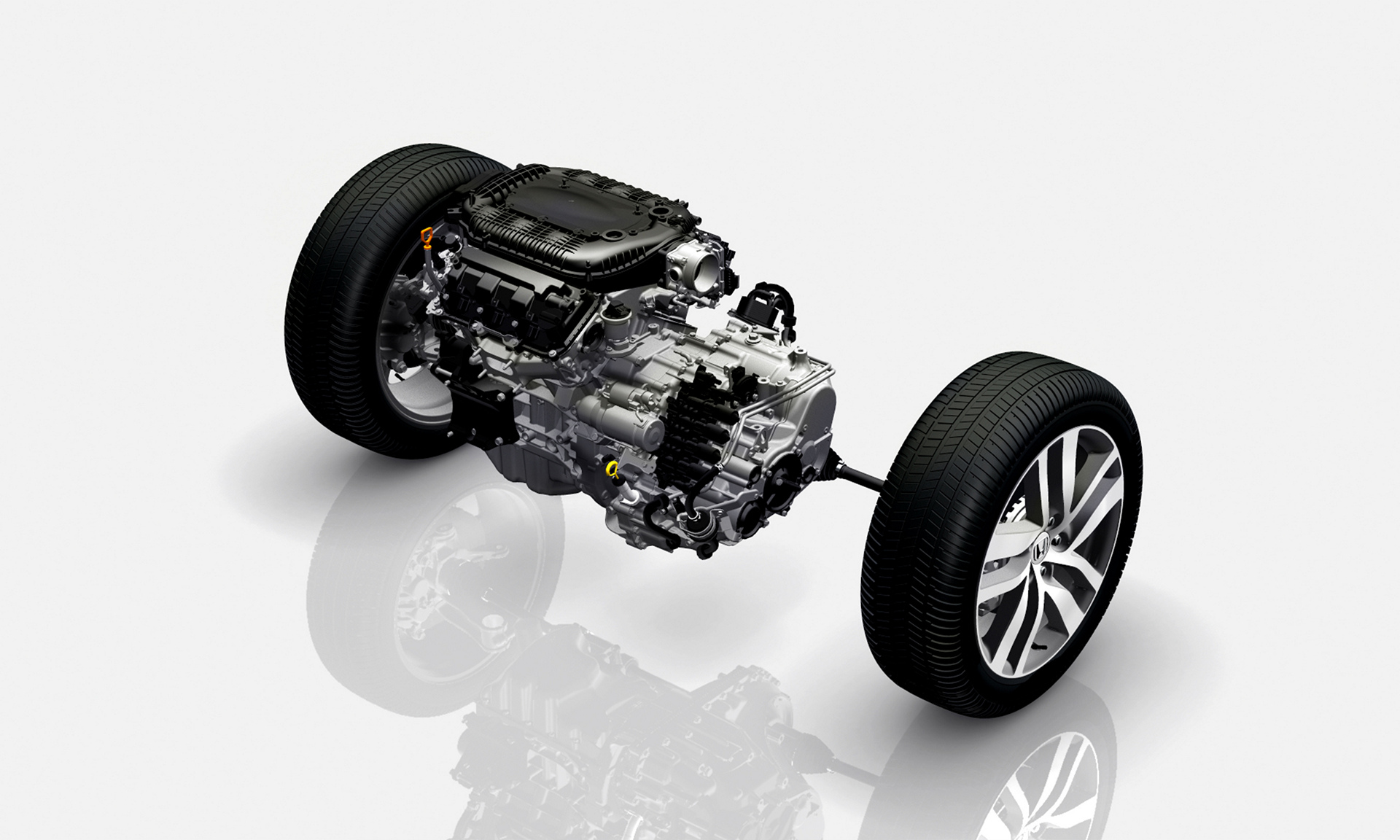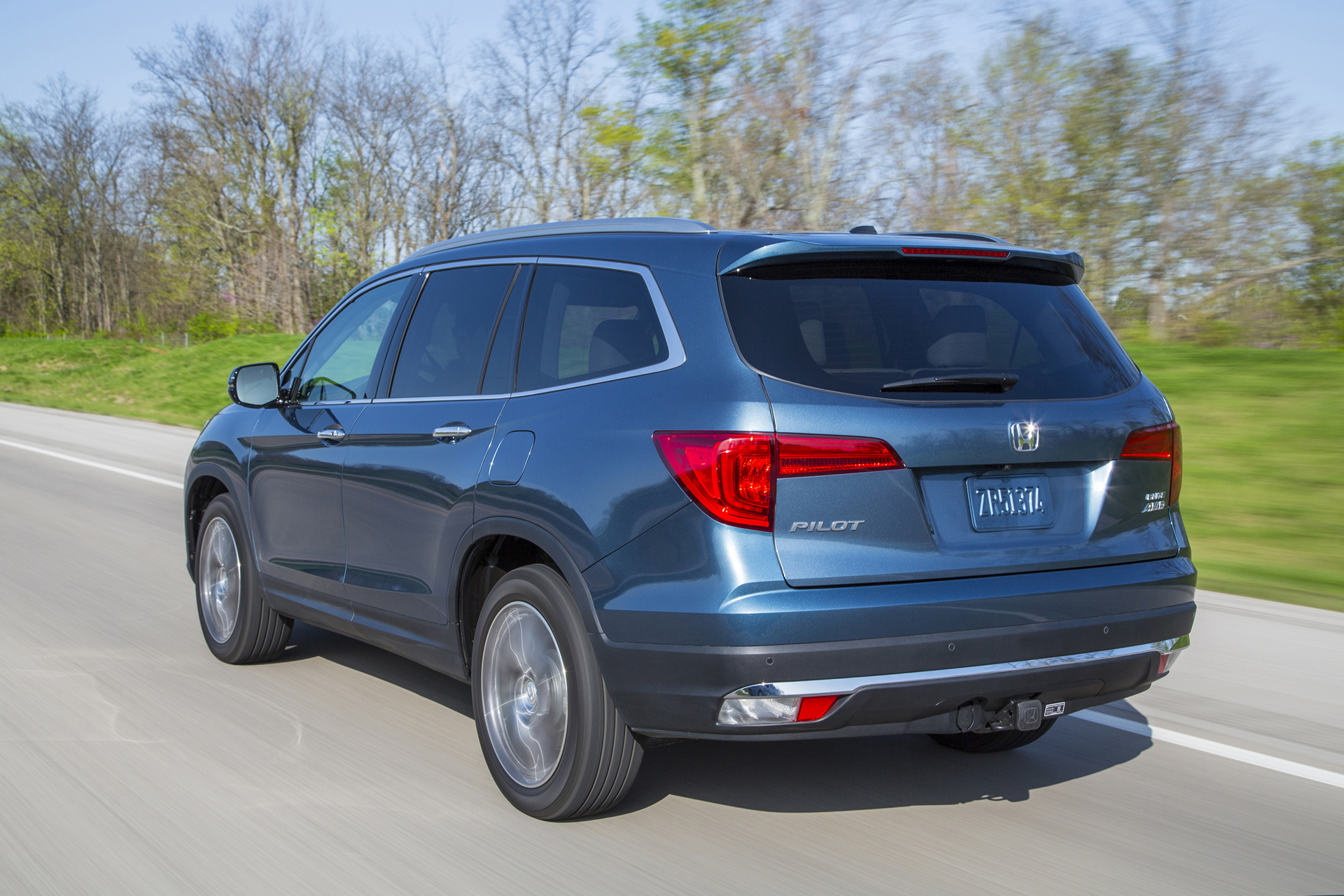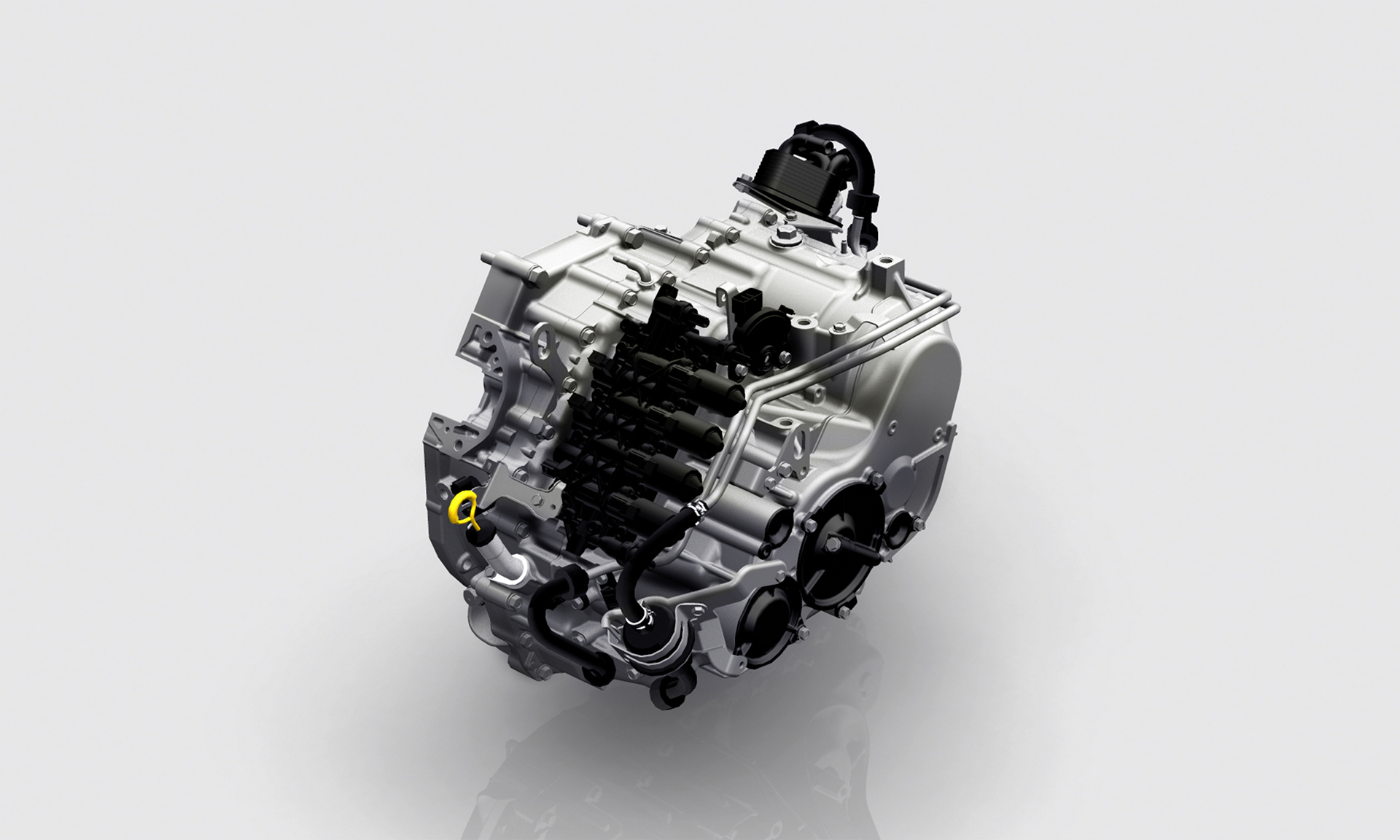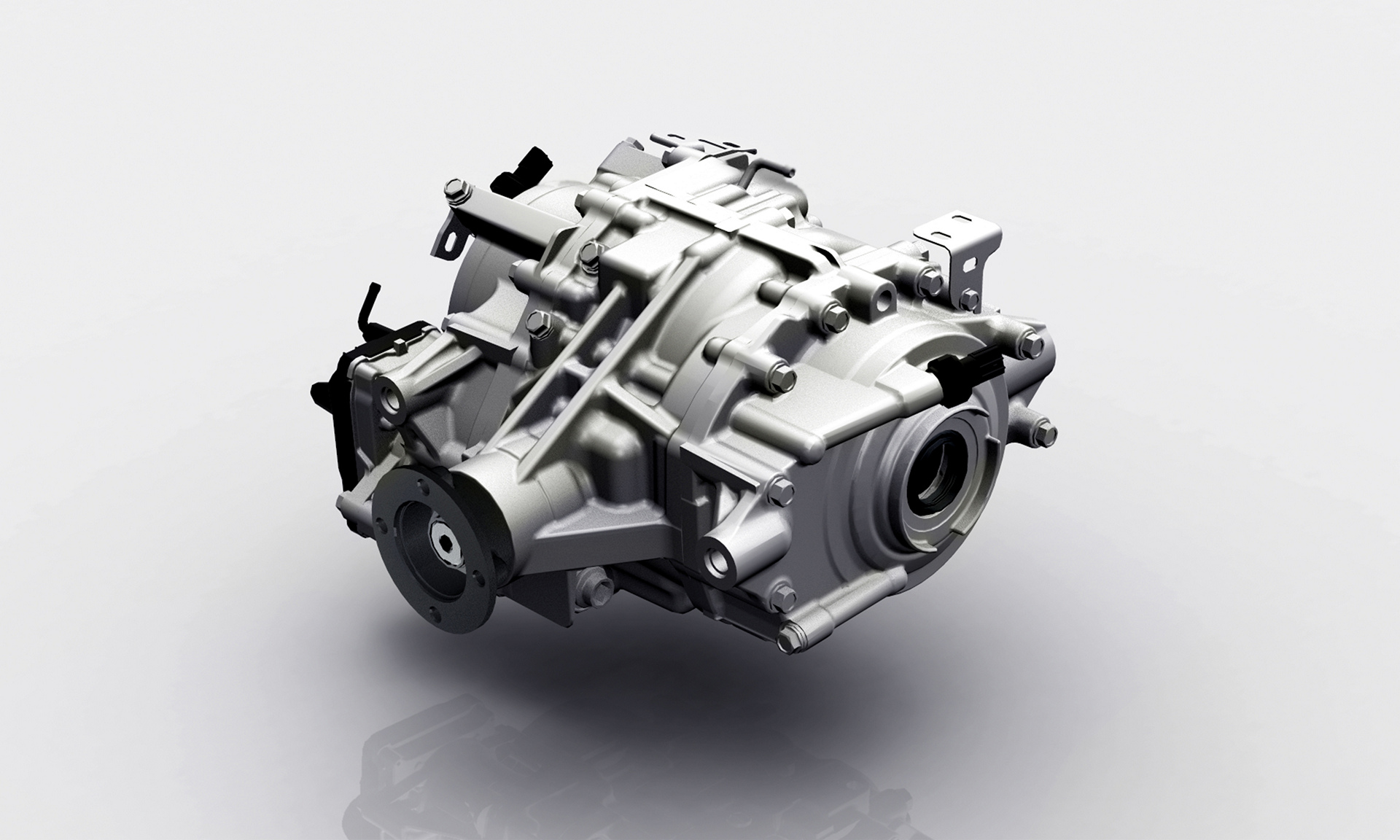The all-new 2016 Honda Pilot SUV, with seating up to eight passengers, joins the Honda CR-V and all-new HR-V as the flagship in an expanded lineup of innovative, benchmark-setting Honda SUVs. It is the third generation of Honda’s popular three-row SUV to be designed, developed and manufactured in America. The new Pilot was designed and developed by Honda R&D Americas, Inc., in Los Angeles and Ohio, and is manufactured exclusively by Honda Mfg. Alabama, Inc. in Lincoln, Alabama.1
Since its arrival in 2003 as the first three-row, mainstream SUV to be developed on a car-like unit-body platform, the Pilot has helped set industry standards for fuel efficiency, spacious and thoughtful interior packaging, safety performance, and dynamic handling performance in the midsize SUV segment. American consumers have responded by purchasing more than 1.4 million Pilots over the past 12 years. Pilot also ties the CR-V in having the highest brand loyalty of any Honda model, with approximately 63 percent of Pilot buyers returning to purchase another Honda vehicle.
Reengineered from the ground up, virtually every aspect of the 2016 Pilot has been thoroughly redesigned to better accommodate the needs of all its occupants – the driver and all passengers – delivering more family-friendly utility, more advanced technology, and more premium attributes and amenities than ever before. The 2016 Pilot also ups the ante for premium refinement with major upgrades to interior quality and more standard comfort and convenience features on all trims, along with the addition of a new, line-topping Elite version that offers a series of Honda-first features including 20-inch wheels and tires, ventilated front seats, heated second-row seats, a heated steering wheel, a first-ever panoramic glass roof and many other luxury features.
The 2016 Pilot receives a new engine from Honda’s EarthDreams® Technology powertrain series – a direct-injected 3.5-liter SOHC i-VTEC® V-6 engine with Variable Cylinder Management™ (VCM®) – along with the available two new advanced transmissions and a class-defining all-new intelligent variable torque management (i-VTM4™) AWD system with Intelligent Traction Management and torque vectoring capability. Together, these features make this the most powerful, refined and capable Pilot Honda has ever offered. These technologies, combined with a nearly 300-pound reduction in vehicle weight (on upper trims), improved aerodynamics and reduced running resistance, make this the most fuel-efficient offering in the midsize SUV segment, with EPA fuel-economy ratings improved by as much as 2/2/2 mpg city/highway/combined2 over the previous model.
The new Pilot also moves to the top of the class in safety performance with the most comprehensive suite of Honda Sensing™ advanced safety and driver-assistive technologies ever offered on a Honda vehicle. Furthermore, the 2016 Pilot adopts the next generation of Honda’s Advanced Compatibility Engineering™ (ACE™) body structure along with a new “3-bone” underbody frame design and new hot-stamped ultra-high strength steel door rings. Taken together, these engineering features and technologies deliver major gains to the Pilot’s collision avoidance and collision protection capabilities, as it targets the highest available U.S. government (NCAP) and IIHS safety ratings.
New Pilot Features
| Features | LX | EX | EX-L | Touring | Elite |
|---|---|---|---|---|---|
| 6-Speed Automatic Transmission | • | • | • | ||
| 9-Speed Automatic Transmission | • | • | |||
| LaneWatch™ | • | • | • | ||
| Blind Spot Indicator | • | ||||
| Smart Entry | • | • | • | • | |
| Push Button Start | • | • | • | • | • |
| Blu-ray™ DVD Rear Entertainment System | • | • | |||
| Idle Stop | • | • | |||
| One-Touch 2nd-Row Seat^ | • | • | • | ||
| Multi-Angle Rear View Camera | • | • | • | • | • |
| Honda Sensing | Available | Available | • | • | |
| Intelligent Traction Management System^ | • | • | • | • | |
| 8-inch touchscreen Display Audio system with Android operating system +^ | • | • | • | • | |
| Remote Engine Start^ | • | • | • | • | |
| LED Daytime Running Lights | • | • | • | • | |
| LED Headlights with Auto High-Beam | • |
2016 Pilot Pricing and EPA Fuel Economy Ratings
| Trim | Wheel Drive | MSRP3 | EPA MPG2 (city/highway/combined) |
|---|---|---|---|
| LX | 2WD | TBD | 19/27/22 |
| LX | AWD | TBD | 18/26/21 |
| EX | 2WD | TBD | 19/27/22 |
| EX | AWD | TBD | 18/26/21 |
| EX w/Honda Sensing | 2WD | TBD | 19/27/22 |
| EX w/Honda Sensing | AWD | TBD | 18/26/21 |
| EX-L | 2WD | TBD | 19/27/22 |
| EX-L | AWD | TBD | 18/26/21 |
| EX-L w/Honda Sensing | 2WD | TBD | 19/27/22 |
| EX-L w/Honda Sensing | AWD | TBD | 18/26/21 |
| EX-L w/Navi | 2WD | TBD | 19/27/22 |
| EX-L w/Navi | AWD | TBD | 18/26/21 |
| EX-L w/RES | 2WD | TBD | 19/27/22 |
| EX-L w/RES | AWD | TBD | 18/26/21 |
| Touring | 2WD | TBD | 20/27/23 |
| Touring | AWD | TBD | 19/26/22 |
| Elite | AWD | TBD | 19/26/22 |
Premium Style and Features
Exterior
Sleek and modern, confident and athletic, the new 2016 Pilot’s exterior advances Honda’s flagship SUV to the forefront of its class in design, performance and usability. Longer, lower and subtly narrower than the previous model, the third-generation Pilot’s styling adds an extra quotient of sophistication and modern athleticism, while further advancing the family-friendly SUV functionality that has made Pilot a best-seller. Available LED daytime running lights (DRL) and LED projector low-beam headlights – which include the addition of Honda’s new Auto high-beam – further add to convenience, style and functionality.
Key Available Exterior Features:
- Acoustic windshield
- Power tailgate
- LED daytime running lights (DRL)
- LED projector headlights
- LED taillights
- One-Touch Power Moonroof with Tilt Feature
- Panoramic glass roof
Exterior Styling
Starting with a bright-chromed three-bar grille design and sweeping rearward from there, the 2016 Pilot’s all-new exterior design conveys that Honda’s flagship SUV has gone full-force into the wind tunnel. Literally every inch of the exterior surface has been subjected to intensive tuning, backed up by testing, to ensure that the body design is as aerodynamically efficient as it is visually exciting.
The lenses of the projector beam headlights are rakish and aggressive, and the chiseled front fascia and air inlets evoke the high-performance face of a sports car. The hood and front fenders are strengthened with sharp character lines that add a muscular and purposeful air. The long roofline sweeps along in one dramatic curve, reminiscent of an airplane’s wing chord, from the A-pillars all the way back to the C-pillars, where the roofline drops subtly downward and then terminates in a drag reducing spoiler.
Along the body sides, another crisp character line extends from the front wheel arches up and rearward through the Pilot’s rear door handles, further lending the impression of a vehicle in swift flight. Meanwhile, the side sills and lower doors emphasize the Pilot’s wide, firmly planted stance, visually anchoring the Pilot to the road. In back, the wide fender profile, large tailgate and available new LED taillight array further add to the Pilot’s substantial feel, while bright satin trim on the rear fascia contributes to its look of sophistication. Touring and Elite trims cleanly integrate new lower-profile, silver-finished roof rails with reduced aerodynamic drag versus the previous design.
Tailgate Design and Features
The top-hinged tailgate function has been substantially refined and simplified on the 2016 Pilot. On all Pilot models, the tailgate now features fixed glass, reducing weight and complexity. As before, the tailgate glass incorporates an electric defogger system, activated by a button on the dash, along with an intermittent rear wiper and washer nozzle.
Pilot EX-L and above trims receive an improved power tailgate design. Instead of using a motor, lever and arm system to open and close the tailgate as in previous models, the new 2016 Pilot uses a spindle-type strut on the left side. This “active” strut contains a small electric motor and planetary gear set. Fully sealed, the spindle-type strut lends the tailgate area a cleaner appearance while also helping to improve cargo room.
The power tailgate can be operated via the remote key fob, from a button on the driver’s door panel, a button above the rear license plate (for opening) or from a button located inside the tailgate (for closing).
LED Lighting
The 2016 Pilot incorporates a wide range of available light-emitting diode (LED) exterior lighting features, including LED taillights, LED Daytime Running Lights (DRL), and LED low-beam projector headlights.
LED Daytime Running Lights (DRL)
The Pilot EX, EX-L, Touring and Elite trims have bright, distinctive LED Daytime Running Lights (DRL). A signature design feature of the new Pilot, the DRLs utilize a wing shape positioned above and beside the round projector low-beams. Shaped to match the taut, athletic look of the new Pilot, the LED DRL array is wider at the side and thinner on top, gradually tapering as it moves toward the inside of the headlight lens. Stylistically, the DRLs strongly and clearly define the front corners of the Pilot.
LED Projector Headlights
Exclusively on the Pilot Elite, LED low-beam projector headlights provide improved nighttime illumination and visibility compared to contemporary high-intensity discharge (HID) headlights. Besides improving driver confidence and passive safety, the LED headlights use less energy, helping to enhance fuel efficiency by reducing engine loads. In addition, the LED headlights last up to three times longer than HID headlights and up to six times longer than halogen headlights – contributing to less frequent replacement and the associated cost savings. An auto on/off function is included, and the low-beams are also keyed to the remote key fob operation.
LED Taillights
All 2016 Pilot trims feature LED taillights, whose wing-shaped appearance matches the signature design of the available front LED DRLs. As with the DRLs, the LED taillight array is wider at the side and thinner on top, gradually tapering as it moves across the taillight lens.
Windshield Wipers with Rain Sensing
The 2016 Pilot’s new wiper design uses fewer parts – 11 versus 17 on the previous model – to reduce replacement cost. The wiper arms are also placed lower on the front cowl, completely out of the driver’s view when the wipers are not in operation.
The Pilot Elite includes rain-sensing wipers that automatically activate if water is detected on the windshield. Designed to cover the maximum possible windshield area, the left (driver) and right (front passenger) windshield wipers are 25.6 inches and 23.6 inches long, respectively. The rear wiper is 13.8 inches long.
Exterior Colors
All 2016 Pilot trims are available in eight exterior colors including three metallic and five pearl colors. All colors have a strong character, offering expressive contrasts that complement the Pilot’s body-panel curves and angles, while also exhibiting a smart luxury appearance. The colors are:
Exterior Features
| Features | LX | EX | EX-L | Touring | Elite |
|---|---|---|---|---|---|
| One-Touch Turn Indicators | • | • | • | • | • |
| Integrated Glass Antenna | • | • | • | • | • |
| Acoustic windshield | • | • | • | ||
| Rear privacy glass | • | • | • | • | • |
| One-Touch Power Moonroof with Tilt Feature | • | • | • | ||
| Panoramic glass roof | • | ||||
| Power Tailgate | • | • | • | ||
| Smart Entry | • | • | • | • | |
| Remote Entry | • | ||||
| Programmable Remote Entry | • | • | • | • | |
| Push Button Start/Stop | • | • | • | • | • |
| Walk Away Door Lock | • | • | • | • | |
| LED daytime running lights (DRL) | • | • | • | • | |
| Multi-reflector halogen headlights with Auto-off | • | ||||
| Multi-reflector halogen headlights with Auto-on/off | • | • | • | ||
| LED projector headlights with Auto high-beam and Auto on/off | • | ||||
| LED taillights | • | • | • | • | • |
| Fog lights | • | • | • | • | |
| Variable intermittent windshield wipers | • | • | • | • | • |
| Intermittent rear window wiper/washer | • | • | • | • | • |
| Rain sensing wipers | • | ||||
| Power side mirrors | • | ||||
| Body-colored and heated power side mirrors | • | • | |||
| Body-colored and heated power side mirrors with memory and integrated LED turn indicators | • | • | |||
| Body-colored door handles | • | • | |||
| Chrome door handles | • | • | |||
| Roof rails | • | • | |||
| Body-colored parking sensors (front/rear) | • | • | |||
| Capless fueling system | • | • | • | • | • |
Interior
The 2016 Pilot interior is a clean-slate design that offers new levels of premium quality, convenience and user-friendly technology in an even more spacious, versatile and family-friendly package. The new Pilot reaches higher into the premium end of the market with major upgrades to interior quality and refinement and more premium features than ever before, including available heated and ventilated front seats, a heated steering wheel, heated second-row seats, and a Honda-first panoramic glass roof option – all offered as standard equipment on the new line-topping Pilot Elite trim.
All Pilot trims except for the new Elite trim feature 8-passenger seating with a three-person second-row bench seat. The new 7-passenger Pilot Elite is equipped with two second-row captain’s chairs and a low-profile second-row center console that allows for easy walk through between the second and third rows.
The new Pilot builds on its reputation for best-in-class interior space with one inch more tandem seating space and a 1.3-inch longer cargo area (behind the third-row seat) that allows the new Pilot to hold an 82-quart cooler without compromising third-row seating capacity. Third-row entry and exit is made even easier and more intuitive courtesy of a 1.4-inch lower step in height, a 2.5-inch wider foot entry space and new one-touch second-row seats on EX-L and above trims.
New Available Interior Features:
- One-Touch Power Moonroof with Tilt Feature
- Panoramic glass roof
- LED interior ambient lighting
- Two-position reversible rear cargo lid
- Smart Entry and Pushbutton start
- Heated and ventilated front seats
- Heated second-row seats
- Heated steering wheel
- Second-row captain’s chairs
- One-touch second-row seat
- 8-inch touchscreen Display Audio system with Android operating system
- New-generation “2.0/3.0” SiriusXM® Radio2
- Pandora®2 compatibility
- SMS Text Message function
- HondaLink™ connected-car system
- Idle-Stop
- Blu-ray™/DVD/CD Rear Entertainment System (RES)
Interior Styling
The new Pilot interior takes the refinement of Honda’s flagship SUV to a whole new level with high-quality, soft-touch materials and premium touches applied liberally throughout, including a leatherette dash board upper with stitch pattern and available LED accent lighting in the first two rows. The instrument panel is highlighted by striking new high-contrast instrumentation, a 4.2-inch full-color Multi-Information Display (MID) and a larger 8-inch Display Audio touchscreen. Fit, finish and materials have received close attention, and soft leather seating is standard on EX-L and higher trims.
Interior Colors
| Exterior Color Options | Interior Color(s) Options | ||||
|---|---|---|---|---|---|
| LX | EX | EX-L | Touring | Elite | |
| Black Forest Pearl | Beige | Beige | Beige | Beige | Beige |
| Crystal Black Pearl | Gray | Gray | Gray or Black | Gray or Black | Gray or Black |
| Dark Cherry Pearl | Beige | Beige | Beige | Beige | Beige |
| Lunar Silver Metallic | Gray | Gray | Gray | Gray | Gray or Black |
| Modern Steel Metallic | Gray | Gray | Gray or Black | Gray or Black | Gray or Black |
| Obsidian Blue Pearl | Gray | Gray | Gray | Gray | Gray |
| Steel Sapphire Metallic | Gray | Gray | Gray | Gray | Gray |
| White Diamond Pearl | Beige | Beige | Beige | Beige | Beige or Black |
Versatile, Spacious and Family Friendly Cabin
The Pilot has always been appreciated for its incredibly roomy and versatile cabin and user-friendly design, and the new third generation builds on that reputation. With completely redesigned packaging, the Pilot has a lower floor compared to the previous generation, with seating that is about 1.0 inch lower in the first row, 1.2 inches lower in the second row, and 2.2 inches lower in the third row. The distance between the first and third row hip-points has been increased by 1.0 inch. The panoramic glass roof (on Elite trims) adds to the feeling of open airiness, and has a motorized sunshade controlled from the first row seats.
Cargo Carrying
The Pilot’s cargo area is designed with versatile utility in mind. The Pilot’s Flexible Cargo Management System features a two-position cargo lid that lets you hide cargo in a lower compartment, out of sight. It can also be repositioned at the bottom on the cargo compartment to make room for taller cargo. In this mode, the Pilot can accommodate a large 82-quart ice chest without folding the third-row seats. The cargo lid is also reversible – carpeted on one side and with a durable and water resistant hard plastic surface on the flipside – perfect for holding wet or dirty items. A side compartment is designed to handle small items, like groceries or a gallon of milk. The cargo area’s flat floor makes loading easier. A 12-volt power outlet is positioned in the cargo area for greater convenience on EX and above trims.
Behind the third row of seating, the Pilot LX offers 18.5 cubic feet1 of storage area. The third-row seats are split 60/40, and each side can be folded flat. This opens up a total of 55.9 cubic feet1 of space behind the second row of seating. With both the second and third rows of seating folded, the Pilot offers a maximum of 109.0 cubic-feet1 of cargo space.
Multi-Function Center Console
The Pilot interior offers a range of convenient storage features for the driver and passengers. The center console is specially engineered to offer tremendous versatility and utility. Up front, it has a smartphone tray and a pair of cupholders. The main storage compartment is topped by a sliding tambour door that disappears from view when opened, instead of getting in the way as a hinged lid might. When closed, it creates a large, rigid and flat surface upon which items, like a purse, can be placed. Inside is a sliding smartphone tray, along with a 12-volt power outlet and USB4 and auxiliary jacks. The interior compartment is large enough to accommodate a purse or up to five iPads.
The rear of the center console includes automatic climate controls for the second-row passengers. When equipped with a Rear Entertainment System (RES), controls for its operation are also located here.
Steering Wheel
The steering wheel, leather-wrapped on EX-L and above trims, incorporates the most commonly used controls, allowing the driver to keep their hands on the wheel and their eyes on the road.
In all trims, the steering wheel offers manual tilt and telescopic adjustment. Bluetooth® HandsFreeLink® and audio system controls are located on the left side of the steering wheel; cruise control and Multi-Information Display (MID) controls are on the right side. Trims with Honda Sensing™ have LKAS and ACC controls located on the right side of the steering wheel as well. On Touring and Elite trims, tucked out of view but within fingertip reach are a pair of paddle shifters that allow for manual operation of the 9-speed transmission. A heated steering wheel is standard in the Pilot Elite.
One-Touch Power Moonroof with Tilt Feature
The Pilot EX-L, Touring and Elite trims feature a power tilting and sliding front moonroof with a manual sunshade. To tilt or slide the moonroof, the driver or front passenger needs only to fully press the ceiling-mounted switch once (instead of pressing and holding it for several seconds). The moonroof fully opens or closes automatically. However, if the operator wishes to only partially open or close the moonroof (such as to achieve partial ventilation), a lighter touch yields fully manual control. The moonroof can also tilt to provide ventilation. An auto-reverse feature is built in, helping to mitigate the possibility of a pinched finger or limb. If the moonroof motor’s ECU detects a threshold level of mechanical resistance, indicating a possible obstruction, the motor will automatically reverse and reopen the moonroof.
Panoramic Glass Roof
The Pilot Elite exclusively features a standard fixed panoramic glass roof over the second- and third-row seats. The glass panel adds to the feeling of open airiness, and has a motorized sunshade controlled from the first row seats. The Pilot structure is engineered to accommodate the panoramic glass roof while still meeting crucial roof crush safety standards and minimizing intrusions to the cabin space.
Power Windows, Locks and Mirrors
Power windows are standard equipment on all Pilot models and include auto-up and -down operation on the driver’s and front passenger’s windows. Power door locks and power mirrors are standard equipment on all Pilot models. Pilot AWD models EX and above include heated exterior mirrors. Smart entry is standard on Pilot EX and above trims.
Sliding Sunvisors
To provide more flexible shading from the sun, all Pilots come equipped with sliding driver and front passenger sunvisors that can be extended 6.1inches along their mounting shaft, a distance that provides perpendicular shade for the eyes even when the front seats are in their rear-most position.
Second-Row Sliding Sunscreens
For increased rear-seat privacy, reduced solar loading and glare, Pilot trims with the Rear Entertainment System have standard manually operated sunshades for each rear door side window.
Auto-Dimming Rearview Mirror
Pilot EX-L, Touring and Elite trims feature an electro chromatic interior rearview mirror that automatically dims during nighttime driving to reduce glare from the headlights of following vehicles.
Meter
The Pilot has analog instrumentation with large tachometer on the left and coolant-temperature and fuel-level gauge on the right of a central 4.2-inch full-color Multi-Information Display (MID) that provides a range of information and trip computer functions. The digital speedometer is prominently positioned front-and-center above the MID.
The gauge package progressively illuminates to give the driver a welcoming feel upon entry. When the door is first opened, the instrument lighting illuminates and then brightens progressively to 100-percent illumination when the ignition is switched on. The illuminated instrument panel then comes alive, indicating that the car is ready to go. At the end of the drive, the instrument lighting dims progressively.
Multi-Information Display (MID)
The Pilot instrument panel provides important vehicle information via a Multi-Information Display (MID) positioned centrally in the meter panel. Controls positioned on the right side of the steering wheel allow the driver to cycle the MID display through multiple screens of information from sources including LKAS, ACC and more. The Maintenance Minder™ system alerts the Pilot driver of upcoming maintenance needs via the MID and should a fault occur with the vehicle, specific warning information will appear. The display indicates when to change the oil, air cleaner, transmission fluid, spark plugs or coolant, as well as when to rotate the tires.
Multi-information Display Features
| Features | LX | EX | EX-L | Touring | Elite |
|---|---|---|---|---|---|
| 4.2-Inch Color LCD Screen | • | • | • | • | • |
| Average Fuel Economy Indicator | • | • | • | • | • |
| Door and Tailgate-Open Indicator | • | • | • | • | • |
| Engine Oil-Life Indicator | • | • | • | • | • |
| Gear Position Indicator | • | • | • | • | • |
| Hood Open Indicator | • | • | |||
| Instant Fuel Economy Indicator | • | • | • | • | • |
| Miles-to-Empty Indicator | • | • | • | • | • |
| Odometer and Trip Meters (2) | • | • | • | • | • |
| Starter System Indicator | • | • | • | • | • |
| Tire Pressure Monitoring System (TPMS) with Tire Fill Assist and Location and Pressure Indicators | • | • | • | • | • |
| Intelligent Traction Management System | • | • | • | • | |
| Exterior Temperature Indicator | • | • | • | • | |
| Compass | • | • | • | • | |
| Turn-By-Turn Directions | with Navigation | • | • | ||
| Corner and Backup Sensor Indicator | • | ||||
| Customizable Feature Settings | • |
Advanced and Intuitive Instrumentation and Controls
All important systems and controls in the Pilot are positioned within easy reach of the driver. Controls for the systems used most frequently – audio, cruise control, Bluetooth®5 HandsFreeLink®, available navigation system with voice recognition and Multi-Information Display – are conveniently positioned on the steering wheel. The main instrumentation is an easy-to-read analog design, supplemented with digital and graphic displays. Typical of Honda interior design, the soft-touch switchgear of the Pilot is engineered to deliver a high-quality feel and positive action. A new standard multi-angle rearview camera provides a choice of three different views.
Instrumentation
| Features | LX | EX | EX-L | Touring | Elite |
|---|---|---|---|---|---|
| 12-Volt Battery-Charging System Indicator | • | • | • | • | • |
| ABS Indicator | • | • | • | • | • |
| Airbag System Indicator | • | • | • | • | • |
| Brake System Indicator | • | • | • | • | • |
| Coolant Temperature Indicator | • | • | • | • | • |
| Cruise Control Indicators | • | • | • | • | • |
| Digital Speedometer | • | • | • | • | • |
| ECON Button | • | • | • | • | • |
| ECON Mode Indicator | • | • | • | • | • |
| Electric Power Steering (EPS) Indicator | • | • | • | • | • |
| Fuel Level Indicator | • | • | • | • | • |
| Headlights-On Indicator | • | • | • | • | • |
| High-Beam Indicator | • | • | • | • | • |
| Immobilizer System Indicator | • | • | • | • | • |
| Low-Fuel Indicator | • | • | • | • | • |
| Low-Oil Pressure Indicator | • | • | • | • | • |
| Malfunction Indicator | • | • | • | • | • |
| Seat-Belt Reminder Indicator | • | • | • | • | • |
| Security System Indicator | • | • | • | • | • |
| System Message Indicator | • | • | • | • | • |
| Tachometer | • | • | • | • | • |
| TPMS Indicator | • | • | • | • | • |
| Turn Signal/Hazard Indicators | • | • | • | • | • |
| VSA System and VSA-Off Indicators | • | • | • | • | • |
| AWD System Indicator | AWD Models | AWD Models | AWD Models | AWD Models | • |
| Fog Lights Indicator | • | • | • | • | |
| Smart Entry System Indicator | • | • | • | • | |
| Adaptive Cruise Control (ACC) On and System Indicators | with Honda Sensing | with Honda Sensing | • | • | |
| FCW / CMBS Indicator | with Honda Sensing | with Honda Sensing | • | • | |
| Lane Keeping Assist System (LKAS) On and System Indicators | with Honda Sensing | with Honda Sensing | • | • | |
| LDW / RDM Indicator | with Honda Sensing | with Honda Sensing | • | • | |
| Idle-Stop On and System Indicators | • | • | |||
| Sequential Mode Gear Selection Indicator | • | • | |||
| Auto High-Beam Indicator | • | ||||
| Blind Spot Information System (BSI) Indicator | • |
Engine Immobilizer
Complementing the remote entry system is a standard engine-immobilizer system. A special electronically coded key prevents the car from being started-even if a mechanical duplicate of the key is used. A transponder, built into the key, signals the immobilizer control unit that the key is genuine. If the car is hot-wired, or an unauthorized key is used, the engine will not start.
Transmission Controls
In the Pilot LX, EX and EX-L, the 6-speed automatic transmission has a conventional straight-gate shifter that is intuitive and easy-to-use and takes up little space in the center console. In the Touring and Elite models with a standard 9-speed automatic transmission, the conventional console-mounted shift lever is replaced with a fully electronic, shift-by-wire gear selector. Park, Neutral, Drive and Sport are selected with the push of a button.
Chassis
The 2016 Pilot utilizes an all-new chassis developed from the ground up to provide exceptionally high levels of ride comfort and confidence-inspiring handling and braking performance, while also making critical contributions to the even more family-friendly interior package, class-leading fuel efficiency and safety performance. Working in conjunction with the new Pilot’s more rigid, lightweight and sound-insulating body structure (see Body section) the new chassis features major improvements to the suspension and steering systems, wheels, wheel bearings, tires and brakes. Also contributing to the dynamic improvements are the Pilot’s lower weight, improved aerodynamics, lower center of mass, and improved horsepower and torque.
The stiffer new body structure allows for more flexibility in optimizing the suspension tuning to deliver significant gains in both dynamic handling performance and better isolation of road noise, vibration and harshness (NVH), as well as expanded third-row passenger space and improved passenger ingress/egress. The new suspension includes the first use of Amplitude Reactive Dampers on the Pilot, further enhancing Pilot’s supple ride, enabling extremely low NVH, and sharpening cornering performance. Standard 18-inch alloy wheels and available 20-inch alloy wheels further improve steering response and overall agility. While more athletic, the Pilot chassis also contributes to lower running resistance, thanks to its low-drag brakes and low rolling-resistance tires. All of these qualities ideally position the 2016 Pilot to satisfy customers who want both a high-level of family-friendly utility and high levels of comfort, quietness and driving confidence.
Key Chassis Features:
— Pilot LX, EX and EX-L
- 4-wheel independent suspension
- Vibration-damping subframes
- Amplitude Reactive Dampers
- Motion-Adaptive Electric Power Steering (EPS)
- 4-wheel disc brakes with ABS1 and Brake Assist
- Vehicle Stability Assist™ (VSA®)2 with Traction Control
- Low rolling-resistance 18-inch M+S tires
- Tire Pressure Monitoring System (TPMS)3 with Tire Fill Assist
- Low running resistance
- Agile Handling Assist
— Pilot Touring and Elite (in addition to or replacing the above)
- 20-inch wheels and lower-profile M+S tires
— Pilot AWD Models
- Trailer Stability Assist
Four-Wheel Independent Suspension
The Pilot independent front and rear suspension systems are engineered to provide long wheel travel and excellent compliance for a supple ride, together with the precise damping and spring rates needed for excellent handling and a sporty driving feel.
Front Suspension
At the front is a strut-type system with forged-aluminum lower control arms, hydraulic bushings, coil springs and a solid stabilizer bar. This setup uses moderate spring rates, relatively firm damping and specially tuned bushings for a smooth, controlled ride with exceptional cornering abilities. The upper front damper mounts provide a “triple path” load-bearing system that helps absorb road vibration and harshness.
Rear Suspension
At the rear is a compact multi-link design with a tubular stabilizer bar. This multi-link system allows a generous amount of wheel travel and excellent compliance for a supple ride, together with confident cornering and handling. All rear suspension control arms are steel – including the high-strength steel upper and lower control arms. Compared to the previous Pilot, the new 2016 Pilot has improved rear-suspension geometry, the upper damper mounts are now located on the body side rails for greater rigidity, and softer bushings are calibrated to reduce road noise without compromising handling.
Also compared to the previous Pilot generation, where the previous setup transmitted suspension loads to the vehicle’s rear wheelhouse, the new setup transmits suspension loads to the more rigid body side frame, which allows for more aggressive tuning of suspension bushings to aid both ride comfort and handling precision. The transmission of road vibration to the second- and third-row seats is also significantly reduced. Further, the elimination of the forward trailing arm on the previous Pilot rear suspension allows for a 1.4-inch lower rear floor that, along with a 1.8-inch longer wheelbase and redesigned second-row seat, provides for easier third-row ingress and egress.
Vibration-Damping Subframes
The Pilot’s engine, transmission, and front and rear suspension systems are mounted on rigid steel subframes. These subframes attach to the unit body at rubber-isolated mounting points that help keep powertrain and road noise, vibration and harshness (NVH) out of the passenger cabin. Two of the rear subframe mounts are filled with specially tuned hydraulic fluid for maximum effectiveness. Permanently sealed, they require no scheduled maintenance. The rear subframe is particularly sophisticated, with hydroformed side elements for maximum strength and minimal weight.
Amplitude Reactive Dampers
Amplitude Reactive Dampers provide superior ride comfort and handling in all driving conditions. The dampers have two separate hydraulic circuits – one tuned to optimize the ride quality on smooth roads with relatively small irregularities, and the other tuned to handle large inputs resulting from rough roads or large steering and braking inputs. As a result, the Pilot remains smooth and supple when cruising, and secure and stable in corners, with reduced body roll.
The primary Amplitude Reactive Damper technology consists of two separate damping pistons: a main piston and a second piston. To improve overall ride comfort, when smaller inputs occur during normal driving conditions, only the main piston works to provide the ideal damping characteristics. To improve the Pilot’s ride and handling on rougher surfaces and during more aggressive driving, the second piston operates to provide additional damping force.
The Amplitude Reactive Dampers are a purely mechanical system that does not require electronic controls. Altogether, they provide a much wider range of effective damping performance than offered by the previous Pilot.
Motion-Adaptive Electric Power Steering (EPS)
Standard on all 2016 Pilot trims, Motion-Adaptive Electric Power Steering (EPS) initiates steering inputs that prompt the driver to steer in the correct direction during cornering and in slippery road conditions. The system works with Honda’s Vehicle Stability Assist (VSA®) and Electric Power Steering, helping to stabilize the vehicle under braking and also help mitigate understeer and oversteer.
The 2016 Pilot utilizes a 16.0:1 steering ratio, approximately 10-percent quicker than the previous Pilot model’s steering. This offers increased agility in all forms of driving, while also complimenting the functionality of the torque-vectoring rear axle on the AWD models. With 3.14 turns lock to lock and a 39.4-foot curb-to-curb turning diameter new Pilot is responsive to steering commands and maneuverable in tight spaces.
The steering column is located by a new cast magnesium steering hanger beam. Rigid and lightweight, the steering hanger beam is a structural member that directly contributes to improved handling and NVH performance.
Four-Wheel Disc Braking System with Electronic Brake Distribution
The 2016 Pilot has 4-wheel disc brakes with a 4-channel anti-lock braking system for a powerful and linear brake feel and confident stops in a wide range of driving conditions. The ventilated front discs are 12.6 inches in diameter and use 2-piston calipers, while the solid rear discs are 13.0 inches in diameter and have single-piston calipers. The calipers utilize a spring-loaded mechanism to maintain separation between the brake pads and rotor to reduce brake drag when not in use, reducing rolling resistance and improving fuel efficiency in the process.
For optimum performance with widely varying loads, Pilot has Electronic Brake Distribution (EBD) system technology. EBD monitors braking force and adjusts front-to-rear brake effort to achieve maximum braking performance and stability. At the rear, a select-low braking strategy is used to help maintain directional stability in slippery driving. In the event one rear wheel verges on lock-up, triggering a pressure modulation at that wheel, brake pressure is also diminished at the adjoining wheel to help preserve the rear axle’s lateral stability. The parking brake is set by stepping on a pedal located on the left side of the driver’s foot well, freeing space in the center console area. The release is located on the lower left side of the instrument panel.
ABS with Brake Assist
The Anti-lock Braking System (ABS) independently modulates braking power at each wheel to help the driver retain steering control during heavy braking. The Brake Assist system recognizes emergency braking situations and almost instantly applies full braking force when appropriate to help shorten braking distance.
Vehicle Stability Assist™ (VSA®) with Traction Control
Vehicle Stability Assist™ (VSA®) is an Electronic Stability Control system that works in conjunction with the Pilot’s Drive-by-Wire™ throttle and its 4-channel ABS systems to enhance control capability while the vehicle is accelerating, braking, cornering or when the driver makes a sudden maneuver. VSA also provides a limited-slip differential effect for the driving wheels by applying braking force to a slipping wheel, thereby redirecting driving force to the wheel with more traction. While the driver can reduce the traction control effectiveness allowing more wheel slip during stuck condition by pressing the VSA button, ABS remains fully operational at all times.
Trailer Stability Assist
Standard on all Pilot models, Trailer Stability Assist helps enhance vehicle stability while a trailer is being towed. An integral part of Vehicle Stability Assist™ (VSA®), Trailer Stability Assist detects trailer oscillations that can result from improper loading, excessive speed, adverse road conditions, crosswinds or emergency-avoidance maneuvers.
When such oscillations are detected, Trailer Stability Assist automatically activates to help damp the oscillations before they can increase and further upset the stability of the vehicle and trailer.
Wheels and Tires
The Pilot LX, EX and EX-L trims have stylish paired 10-spoke design, 18-inch aluminum-alloy wheels with a machined face on EX and EX-L. The Touring and Elite trims have new 20-inch aluminum-alloy wheels with unique, upscale paired 10-spoke design with a machined face.
The Pilot LX, EX and EX-L trims come standard with 245/60 R18 Bridgestone all-season (M+S) tires, while the Touring and Elite trims have lower-profile 245/50 R20 Continental all-season (M+S) tires for enhanced driving performance. All tire choices offer improved steering precision, as well as 10-percent less rolling resistance, than the previous Pilot’s tires, which contributes to greater fuel efficiency. See Low Running Resistance below.
All 2016 Pilot models include a spare tire on a steel wheel that is mounted below the cargo area, where it does not intrude on interior cargo storage space.
Low Running Resistance
Total vehicle running resistance is reduced nearly 20 percent versus the previous Pilot model. In addition to improvements in powertrain efficiency and vehicle aerodynamics, key engineering features for reduced running resistance include:
- Tires with 10-percent less rolling resistance compared to the previous Pilot tires (see Wheels and Tires above).
- Brake calipers that are designed to reduce drag when not in use, reducing rolling resistance by 18.6-percent compared to the previous Pilot braking system.
- A new lightweight, low-drag wheel bearing design further improves overall driving efficiency.
Additional aerodynamic gains are found in the computer-aided engineering (CAE) optimized exterior shape.
Agile Handling Assist
Standard on all Pilot trims, Agile Handling Assist selectively uses the vehicle’s brakes to improve initial turning response and overall cornering ability. Agile Handling Assist utilizes brake vectoring to improve corner traceability and confident handling feel. By applying braking force to the inside wheels during cornering at high lateral G, the system creates a yaw moment, thus generating more turning force and reducing understeer.
Off-Road Capability
Honda engineers took thorough measures to ensure the off-road capabilities of the new Pilot. The vehicle meets design criteria, which was based on research at different off-road areas around the world. This research was the foundation for specific minimum performance criteria for the new Pilot, including off-road friendly approach and departure angles (18 degrees front and 19.7 degrees rear, respectively).
The available AWD system with computer-controlled traction utilization capabilities helps the Pilot meet typical off-road challenges without the need for low-range gears. The system is designed for “decision free” operation, meaning that the driver does not need to actively choose when to engage all-wheel-drive. The system is always active and ready to proportion rear wheel torque as needed.
Towing
When equipped with a Honda dealer-installed accessory towing package, the new 2016 Pilot can tow up to 3,500 lbs. The available towing package includes a Class III hitch, towing kit, and wiring harness. Adding a Honda dealer-installed ATF cooler increases the towing capacity to 5,000 lbs. for AWD models. When not being used for towing, the hitch can double as an attachment point for a genuine Honda accessory bicycle rack.
Chassis Features
| Features | LX | EX | EX-L | Touring | Elite |
|---|---|---|---|---|---|
| MacPherson Strut Front Suspension | • | • | • | • | • |
| Multi-Link Rear Suspension | • | • | • | • | • |
| Stabilizer Bar (mm, front/rear) | 25/26.5 | 25/26.5 | 25/26.5 | 25/26.5 | 25/26.5 |
| Amplitude Reactive Dampers | • | • | • | • | • |
| Electric Power-Assisted Rack-and-Pinion Steering (EPS) | • | • | • | • | • |
| Steering Wheel Turns, Lock-to-Lock | 3.14 | 3.14 | 3.14 | 3.14 | 3.14 |
| Steering Ratio | 16.0:1 | 16.0:1 | 16.0:1 | 16.0:1 | 16.0:1 |
| Turning Diameter, Curb-to-Curb 2WD/AWD (ft.) | 39.4 | 39.4 | 39.4 | 39.4 | 39.4 |
| Power-Assisted Ventilated Front Disc/Rear Solid Disc Brakes (in, front/rear) | 12.6/13.0 | 12.6/13.0 | 12.6/13.0 | 12.6/13.0 | 12.6/13.0 |
| Wheels | 18" alloy | 18" alloy | 18" alloy | 20" alloy | 20" alloy |
| All-Season Tires | 245/60 R18 105H | 245/60 R18 105H | 245/60 R18 105H | 245/50 R20 102H | 245/50 R20 102H |
| Compact Spare Tire | T165/80 D17 104M | T165/80 D17 104M | T165/80 D17 104M | T165/80 D17 104M | T165/80 D17 104M |
Advanced Technology
The new Pilot delivers the connectivity and power access that modern families demand, including up to five USB ports, four that provide better recharging with 2.5-amp output – fully adequate to charge iPads or smartphones while they’re in use. Additional available ports and plugs include an auxiliary jack for nearly any audio player, an HDMI port for a gaming console or other similarly connected device, two headphone jacks, and up to three 12-volt power outlets and a 115-volt AC outlet to power a range of compatible devices.
The new Pilot also incorporates Honda’s latest thinking in advanced, family-friendly technology, including an upsized 8-inch capacitive touchscreen Display Audio connectivity interface powered by a new Android-based operating system and more powerful processor, along with an available all-new embedded Honda Satellite-Linked Navigation System™. The new navigation system features improved graphics and new capabilities, including 3D renderings of terrain, buildings and road signs, improved lane guidance, live search function and more.
The Pilot’s Display Audio system enables simplified smartphone connectivity making for easier access to all the features and connectivity options of the HondaLink® connected-car system. A 9-inch rear entertainment system with DVD and new Blu-ray™ disc capability is available.
Family-Friendly Utility
The new Pilot builds on its reputation for best-in-class interior space, versatility and utility with 3.5 inches of added overall vehicle length, enabling an inch longer tandem seating distance and a 1.3-inch longer cargo area that can hold an 82-quart cooler without compromising third-row seating capability. Third-row entry and exit is made even easier and more intuitive courtesy of the new available one-touch second-row seat on EX-L and above models, and larger third-row entryway. Compared with the current Pilot, the width of the lower portion of the third-row lower entryway has been increased by 2.5 inches with an inch lower step-over height.
The Pilot’s new center console features a cavernous storage compartment capable of accommodating items as large as a full-size iPad or a purse. And with its seamless cover in the closed position, the console provides a convenient, non-slip surface for items that the driver or front passenger may need close at hand.
EarthDreams® Technology Powertrain
The 2016 Pilot delivers more refined, powerful and fuel-efficient performance than ever before courtesy of its new 3.5-liter, direct-injected i-VTEC® V-6 engine with Variable Cylinder Management™ (VCM™) cylinder deactivation technology.
The engine’s peak output of 280 horsepower and 262 lb.-ft. of torque is up 30 hp and 9 lb.-ft. over the previous model.4 The engine is matched to a choice of two new advanced transmissions – a Pilot-first 6-speed automatic transmission or, on upper trims, a Honda-first 9-speed automatic transmission – both delivering more refined, responsive and fuel-efficient performance.
These new powertrains combine with a new, lighter yet more rigid unit-body and aerodynamically efficient body and chassis designs that result in class-leading EPA fuel economy ratings topping out at 20/27/23 mpg (city/highway/combined) for two-wheel-drive models and 19/26/22 mpg for all-wheel-drive models.2
Intelligent Variable Torque Management (i-VTM4™) AWD System
The Pilot’s available new Intelligent VTM4 (i-VTM4) is the most sophisticated and technologically advanced all-wheel-drive system offered in a mainstream, three-row SUV. This entirely more capable system progressively distributes optimum torque between the front and rear axles and, for the first time ever in a Honda vehicle, dynamically distributes engine torque between the left and right rear wheels. Benefits include superior all-weather handling and neutral, accurate steering under power that is more effective than front-drive, rear-drive or conventional all-wheel-drive systems.
Intelligent Traction Management
This new Pilot features a new button-operated Intelligent Traction Management System that offers different operating modes, for the AWD: Normal, Snow, Mud and Sand; and for the FWD: Normal and Snow. Developed, tuned and tested at various locations in the U.S. and around the world – including Imperial Dunes “Glamis”, California; Moscow, Russia; and Dubai, United Arab Emirates – the Intelligent Traction Management system allows the driver to select the operating mode that best suits the driving conditions by simply pushing a button on the vehicle’s center console. Based on the setting selected, the system adjusts the drive-by-wire map, transmission shift map, Vehicle Stability Assist™ and i-VTM4 torque distribution for AWD-equipped models for optimal performance in a variety of road or surface conditions.
Advanced Safety Performance
In keeping with Honda’s commitment to safety, the new Pilot features the most comprehensive set of advanced safety and driver-assistive technologies ever offered on a Honda vehicle. Together these technologies make up Honda Sensing™, a suite of technologies designed to expand the driver’s situational awareness while sensing and responding to potential road hazards, including other vehicles, road obstacles and even pedestrians, even to the point of mitigating the possibility or severity of a collision. It includes a standard Multi-Angle Rearview Camera and a suite of available safety and driver assistive technologies that includes Honda’s popular LaneWatch™ display, a blind spot information system, Collision Mitigation Braking System™ (CMBS™), Lane Departure Warning (LDW), Forward Collision Warning (FCW), Lane Keeping Assist System (LKAS), Adaptive Cruise Control, and two Honda-first technologies: Road Departure Mitigation (RDM) system and Rear Cross Traffic Monitor.
The new Pilot is expected to deliver the highest safety ratings in its class and targets a 5-Star Overall Vehicle Score from the National Highway and Traffic Safety Administration (NHTSA) and a TOP SAFETY PICK+ rating from the Insurance Institute for Highway Safety (IIHS), including a GOOD rating in all crash modes. The new Pilot incorporates Honda’s next-generation Advanced Compatibility Engineering™ (ACE™) body structure, designed to more efficiently absorb and disperse the energy from a frontal collision, along with new ultra-high-strength door rings designed to help better protect occupants. The 2016 Pilot also incorporates an all-new “3-bone” platform while also utilizing high and ultra-high strength body materials, which together reduce noise, vibration and harshness (NVH), improve handling, increase rigidity and reduce weight.
Standard safety and driver-assistive features include four-channel anti-lock brakes (ABS) with Brake Assist and Hill Start Assist; Vehicle Stability Assist™ (VSA®) with Traction Control; an Expanded View Driver’s Mirror; dual-stage, multiple-threshold front airbags, driver and front passenger SmartVent® side airbags and side-curtain airbags for all outboard seating positions; and a new Tire Pressure Monitoring System (TPMS) with real-time display of individual tire pressures.
Price
Recommended retail price (MSRP) starts from $30,145


